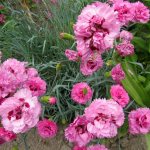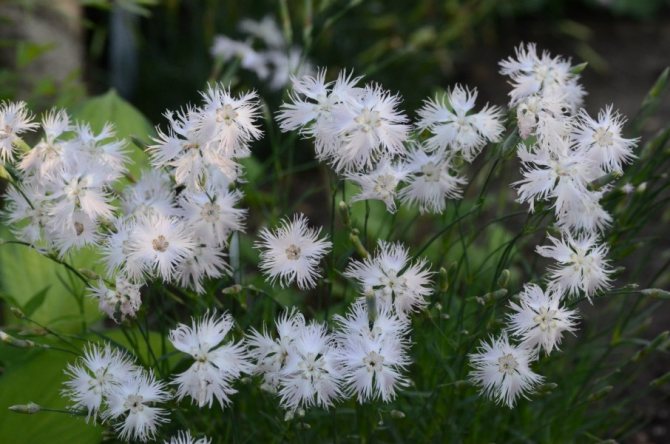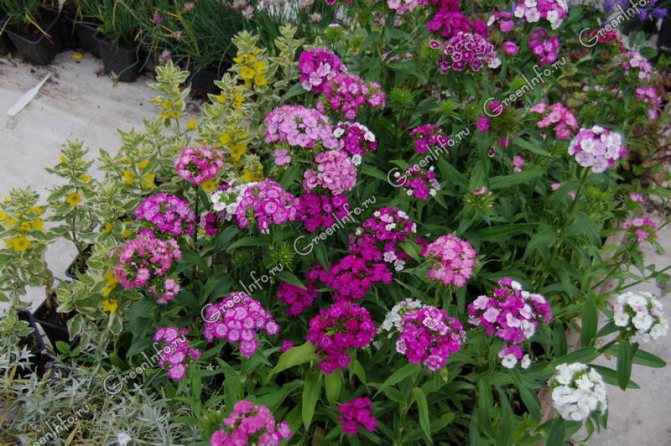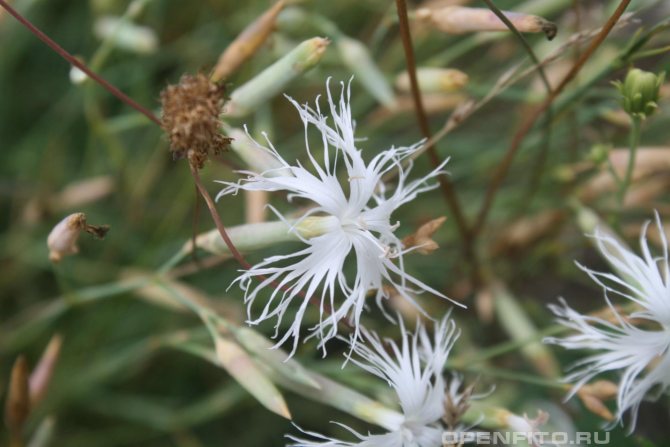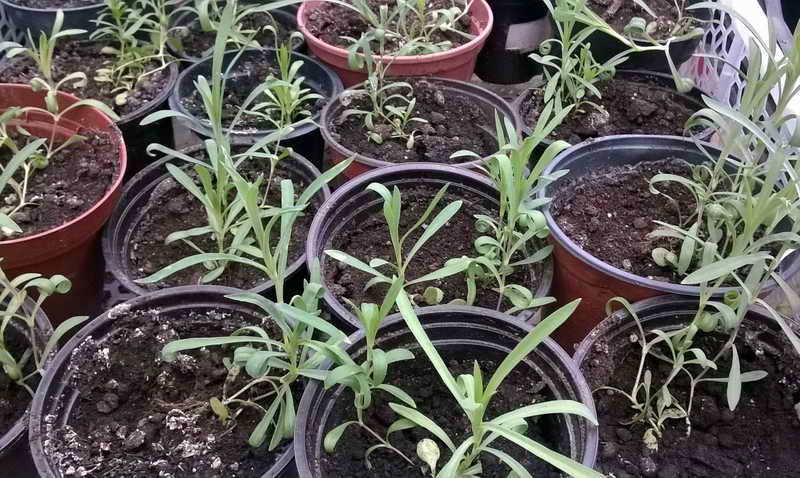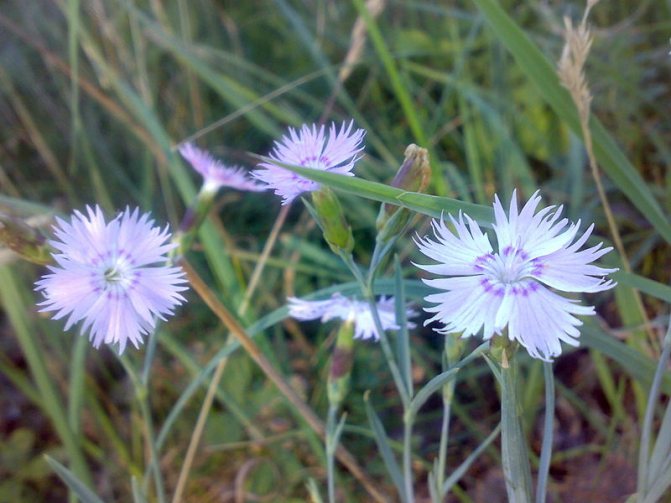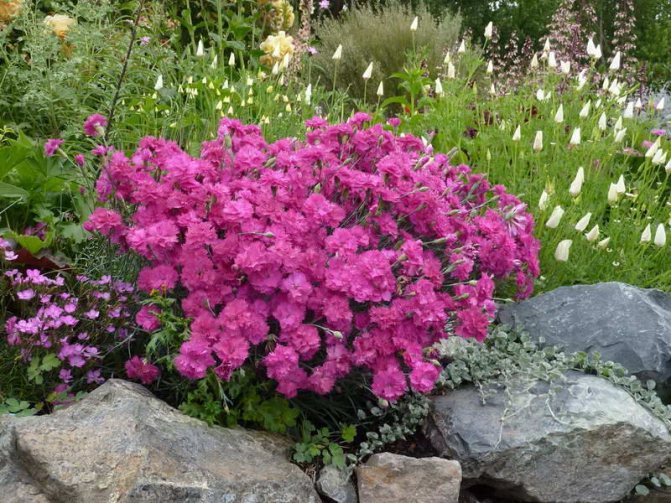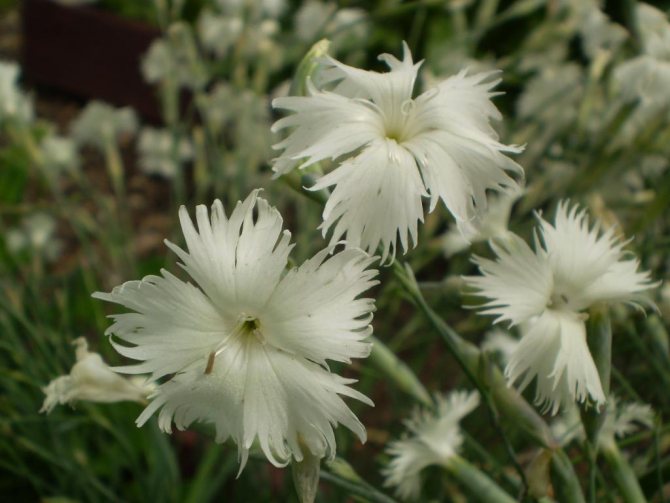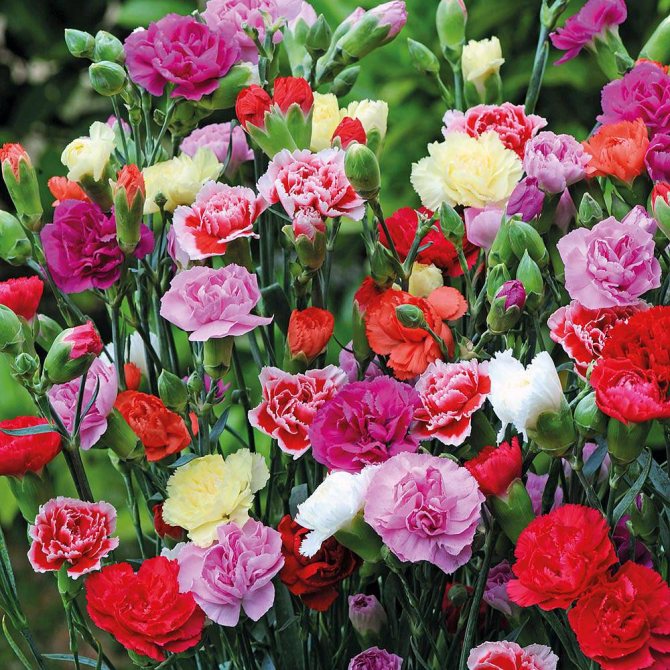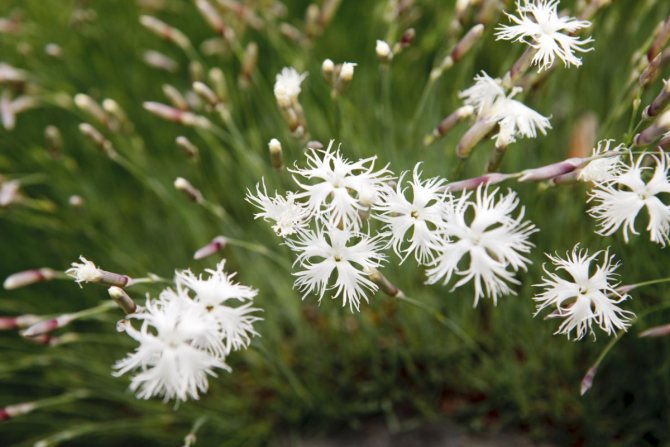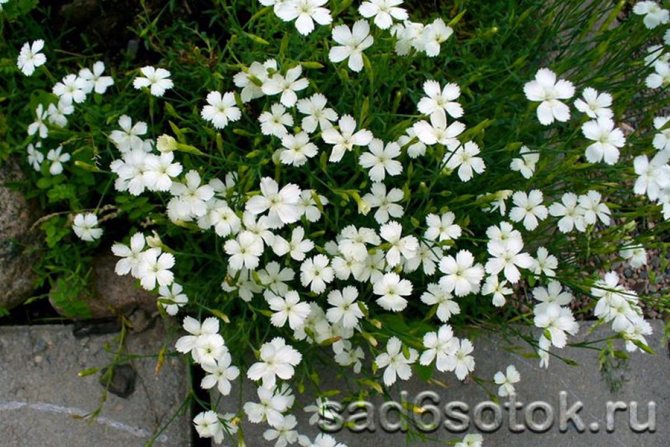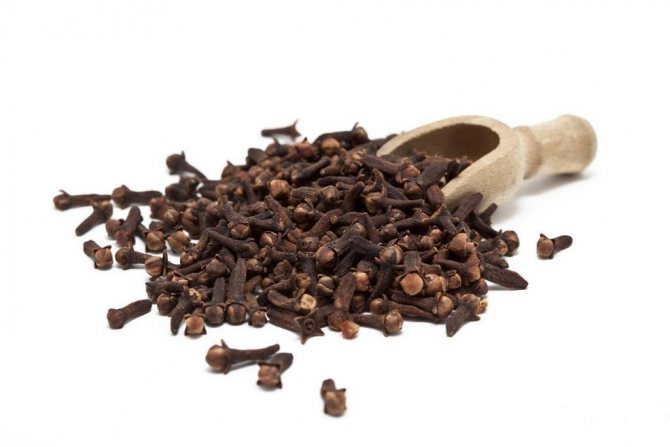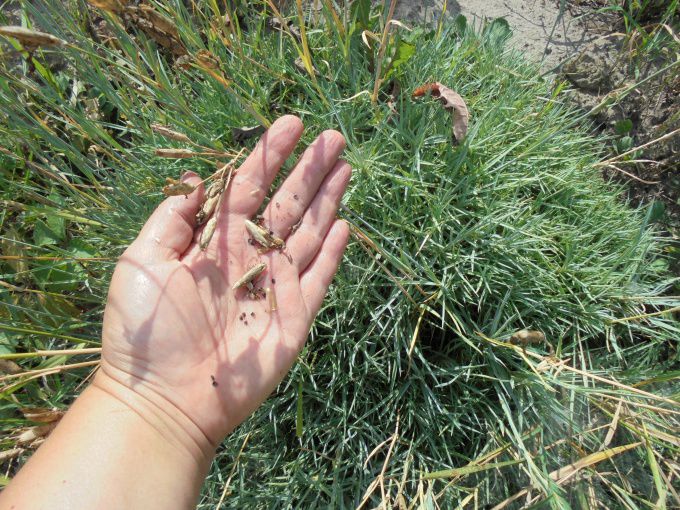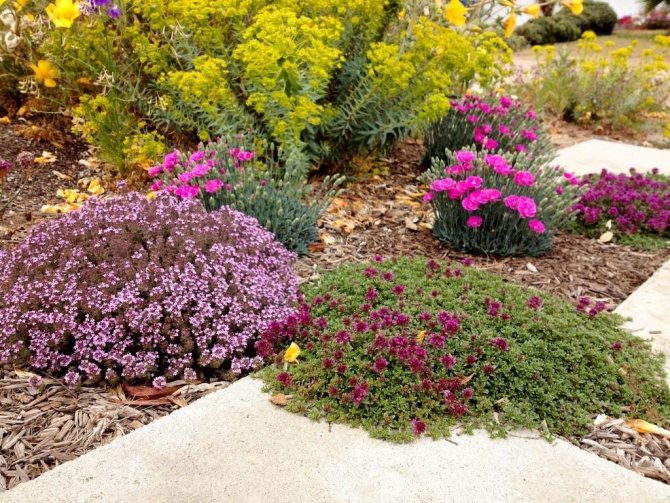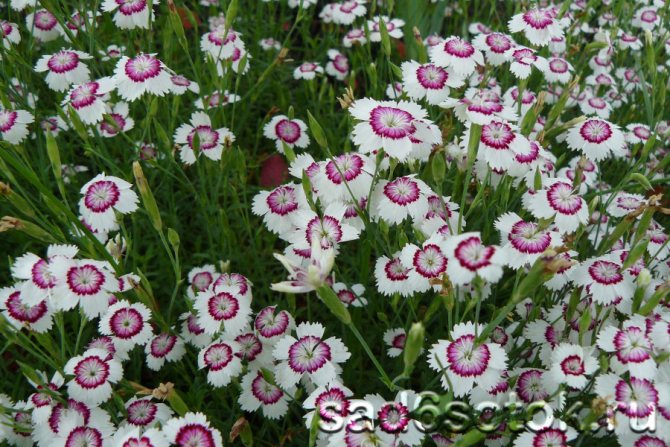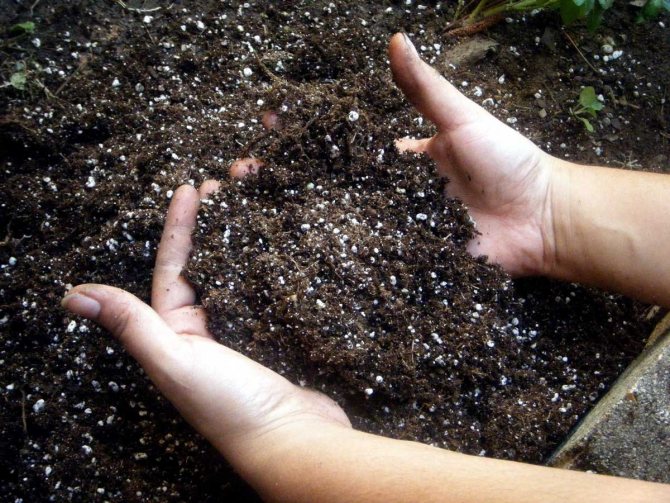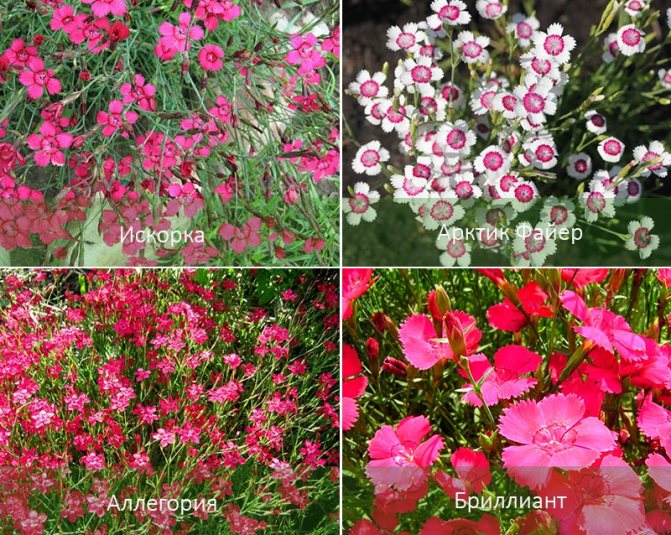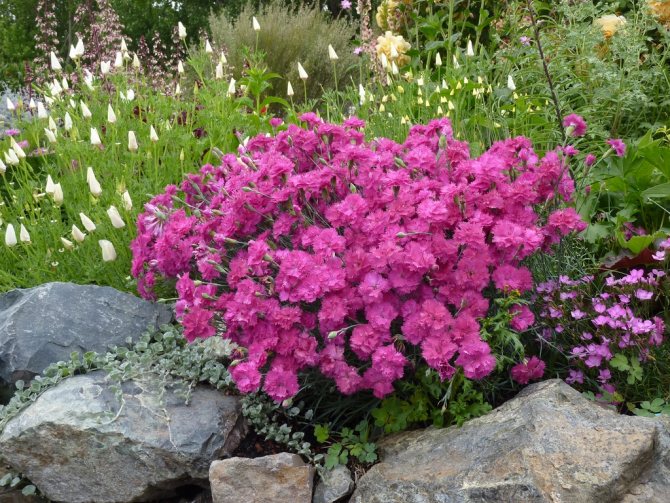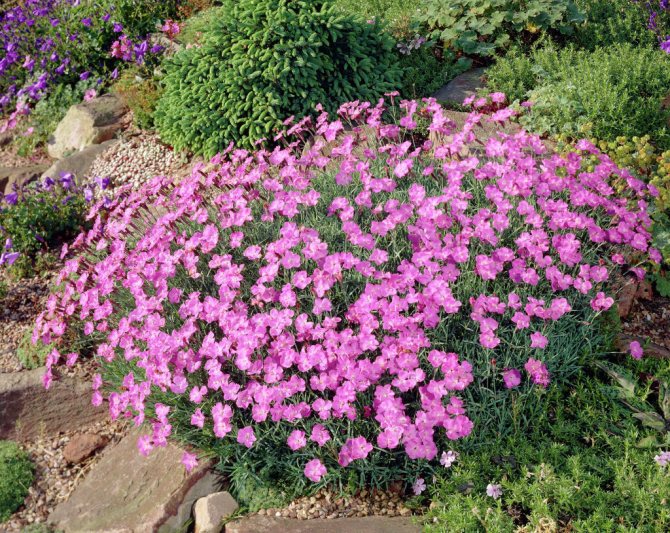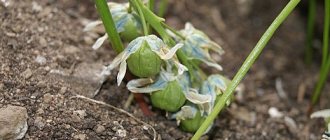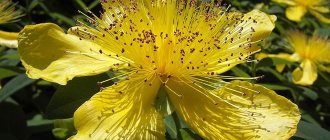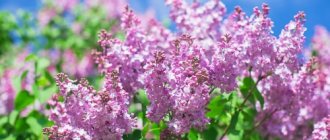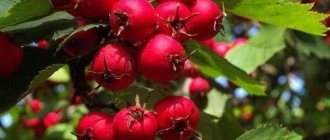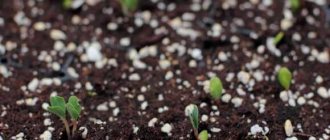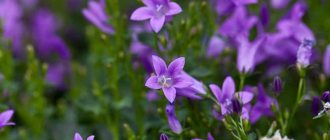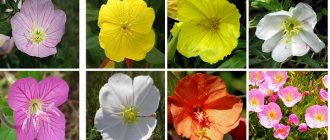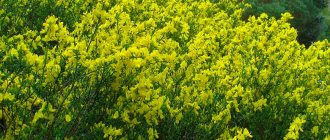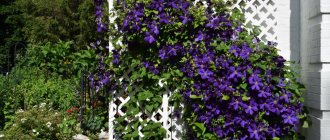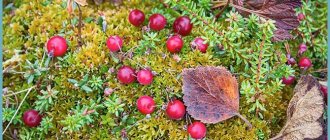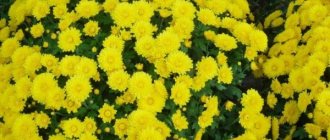Herbal carnation -dianthus deltoides red is a culture that is familiar to almost every grower who is great at alpine slides or rocky gardens, and who regularly takes care of their decoration. The plant is distinguished by its perfect unpretentiousness and the fact that it has very thin and fragile stems. But, nevertheless, they have incredibly decorative emerald-colored foliage, which perfectly complements absolutely any composition, and also looks attractive at any time. During flowering, the herbal carnation is undoubtedly a work of art, since it is distinguished by its colorfulness, and the leaves have fresh and sometimes very unusual torus. Later, they turn into cushion bushes, which more resemble pink, white, crimson clouds. In this article, we will dwell a little more on what features this type of plant has, we will talk about the most popular and demanded varieties, as well as how to properly plant a herbal carnation and take care of it in order to get a really excellent and worthy decorative result.
Carnation Shabo photo
(Dianthus caryophyllus var.scabaud) is one of the most famous varieties, bred in the 19th century by the French pharmacist Shabo, whose name this magnificent flower was given. It is a small compact bush with a height of 30 to 60 cm, with geniculate stems, leaves with a bluish bloom and double or simple large flowers - up to 7 cm in diameter. The color scheme leaves room for imagination - the buds are red, white, pink, purple, yellow. Repaired variety, flowering lasts almost all summer, from late June to late autumn.
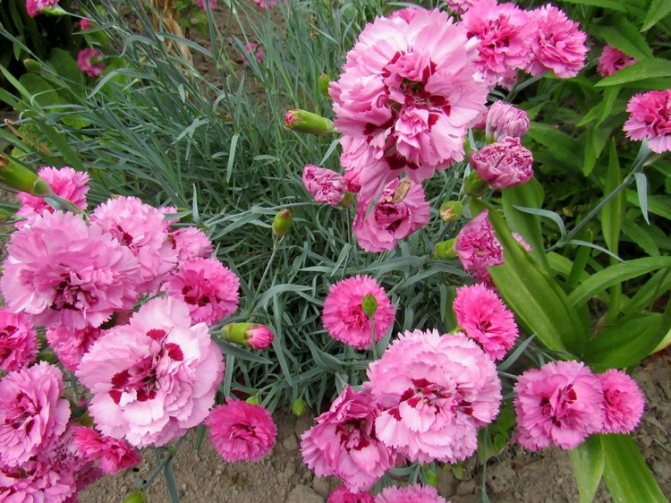
Malmaison varieties
This group of ancient varieties of cloves comes from the name of the palace of Josephine Bonaparte, 20 km from Paris. The palace was famous for its parks, where a variety of flowering plants were grown. Once widely grown in Europe, these old-fashioned varieties produce large, solid flowers with a characteristic spicy clove scent. The flowers of these double carnations form so many petals that the calyx inevitably splits. They are grown and propagated in the same way as remontant varieties of cloves.
Duchess of Westminster
The flowers are bright pink.
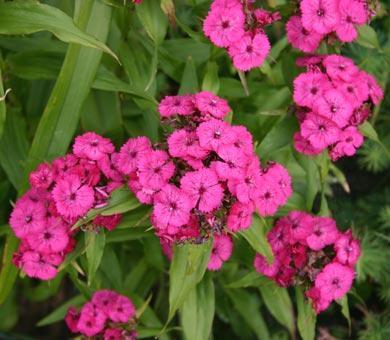

Duchess of Westminster
"Princess of Wales"
A variety with pink flowers.
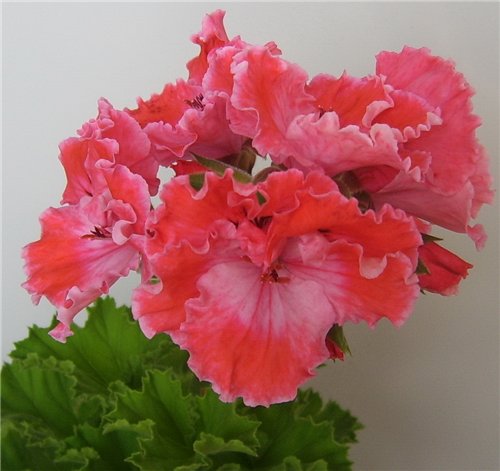

"Princess of Wales"
Souvenir de la Malmaison (Old Blush)
The variety forms flowers with a pink blush.
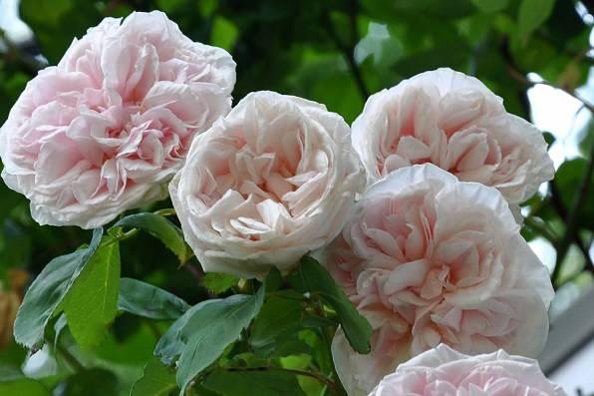

Souvenir de la Malmaison (Old Blush)
"Thora"
Flowers with a red blush.
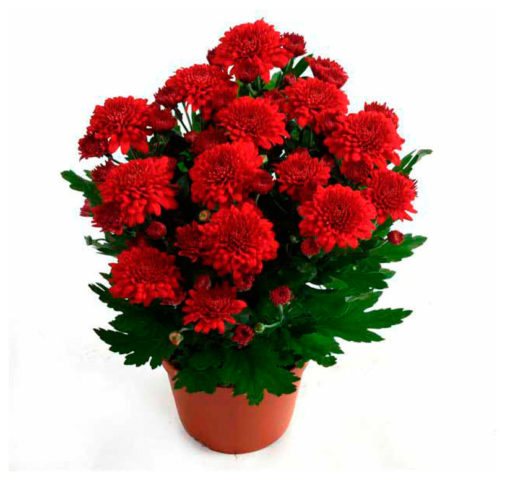

"Thora"
Turkish carnation photo
Turkish carnation, or bearded, is the most popular garden plant that can be found in almost every second garden. And this is understandable! After all, the Turkish carnation has very spectacular flowers, moreover, it has a long flowering - for a month and a half, starting from mid-June. It is a perennial plant commonly grown as a biennial. It grows in the form of small bushes 20–35 cm tall, and in the first year only a rosette of flowers appears, and the plant blooms in the second year, in June. Large inflorescences-shields, resembling caps, have a diameter of up to 12 cm and consist of double or simple small flowers of various colors with a diameter of 1 cm.There are varieties with flowers of the same tone - white, pink, purple, scarlet - and varieties with a variegated color, two or three colors, with a border or an eye. Turkish cloves have a very delicate aroma.
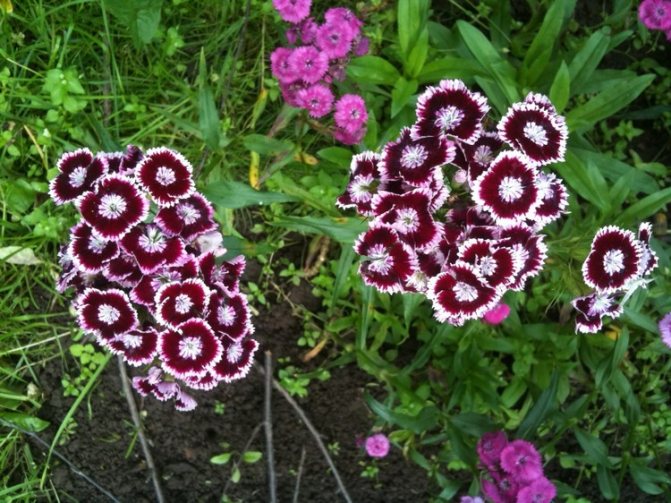

Summary
Clove-herbal: video
Carnation herbal dianthus deltoides red is simply a stunning perennial that has incredibly attractive decorative properties. Very few other plant species can compete with them, as the carnation is an unpretentious, frost-hardy and vibrant plant that produces lush and flowered shrubs. They look great both in single planting and in group compositions. Thanks to such a large number of advantages, the carnation is still an incredibly attractive and significant plant, and, perhaps, will remain so for many years.
Chinese carnation photo
Herbaceous perennial, often grown as an annual or biennial. It grows in the form of a small bush up to 50 cm high. Dwarf forms reach 15 cm. In nature, it grows in Korea, Mongolia and northern China, as an ornamental plant is cultivated all over the world. The leaves are narrow, long, paired, pointed, sometimes curling. Over the years of selection, many spectacular varieties have been bred with bright flowers - white, crimson, lilac, red, purple, which open throughout the season. Flowers are one-color, two-color and variegated, with a contrasting border and an eye. The petals are serrated, sometimes fringed. There are terry, semi-double and non-double varieties. The flowering period is almost all summer, from June to August. There are remontant, continuously flowering varieties, there are varieties that bloom once.
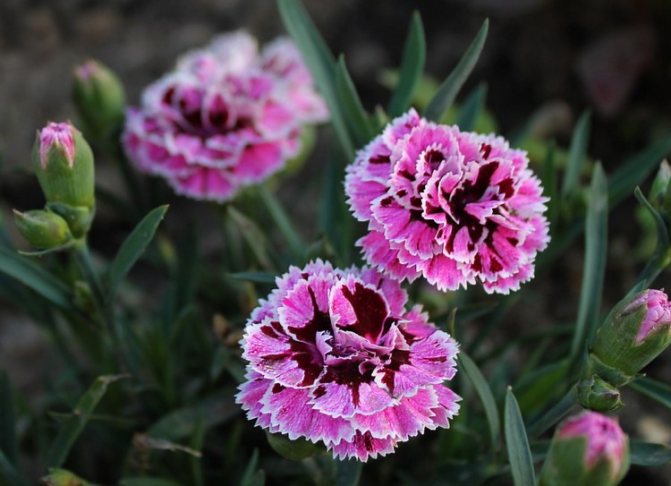

Old fashioned varieties
This group includes old varieties (some of them were already known in the 17th century), as well as modern varieties, which in appearance resemble old-fashioned spreading or bushy carnations. All of them have one flowering period, which lasts 2-3 weeks in early summer. Most of the varieties listed below have double flowers (exceptions are specifically indicated).
Allspice
The flowers are simple, wine-red, with white edges and a few white spots.
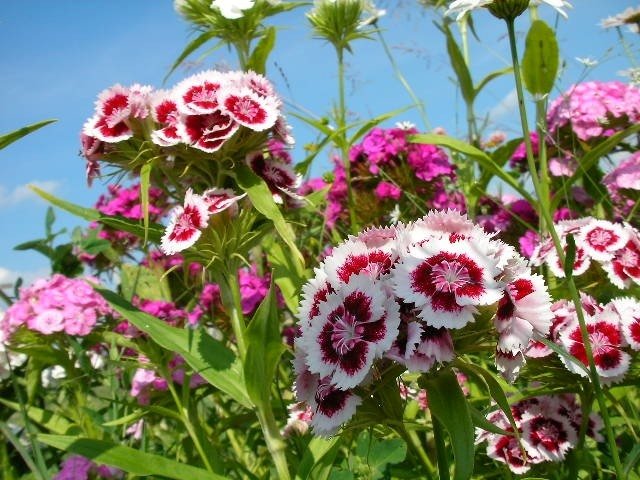

Allspice
Brympton Red
The cultivar forms simple dark pink flowers with darker edges.
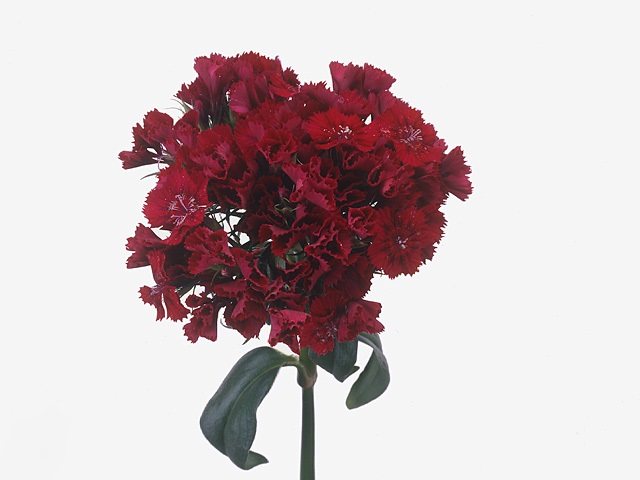

Brympton Red
"Dad's Favorite"
The flowers are corrugated, white, with a bright red central zone and a border around the edge.
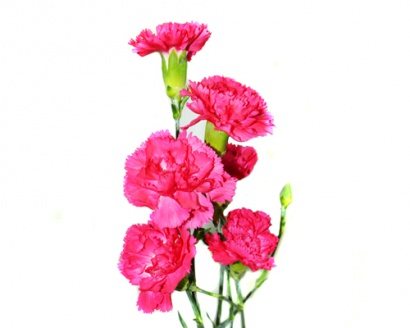

Corrugated flowers
"Inchmery"
The variety gives solid light pink flowers.
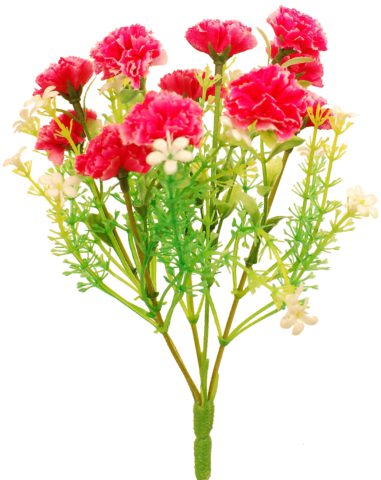

"Inchmery"
"Mrs. Stnkins "
The flowers are white, with a split calyx.
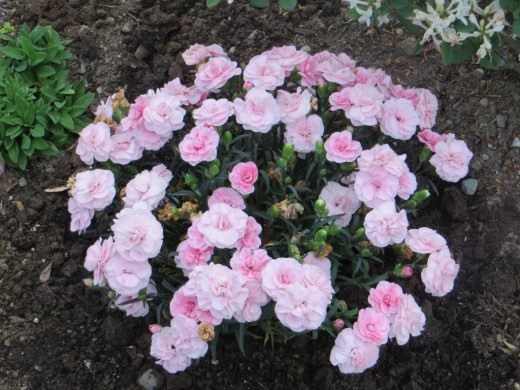

"Mrs. Stnkins "
Musgrave's Pink (syn. Charles Musgrave)
A variety with simple white flowers and a pastel green eye in the center.
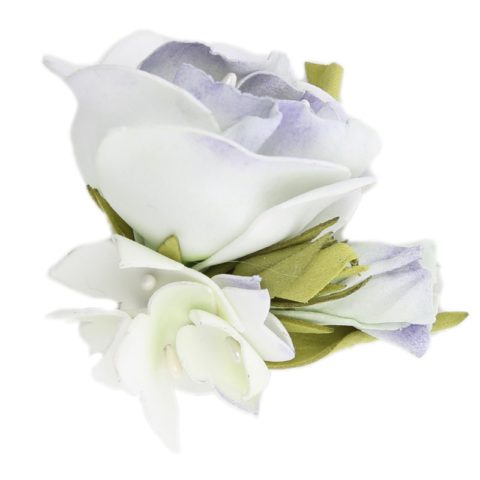

"Musgrave's Pink"
"Sam Barlow"
The flowers are white, with a dark purple-burgundy central zone.
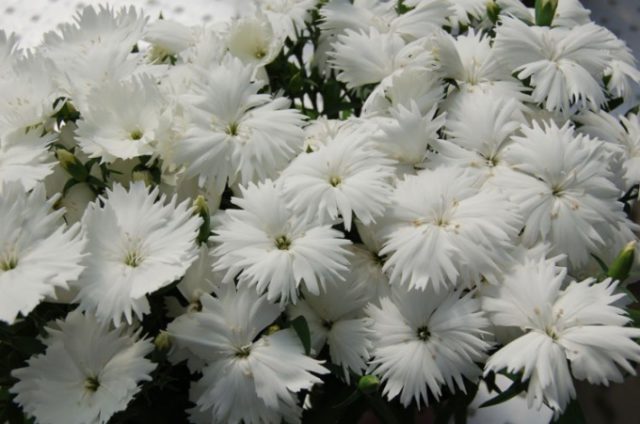

"Sam Barlow"
"Sops-in-Wine"
The cultivar forms white flowers with a dark purple-crimson central zone.
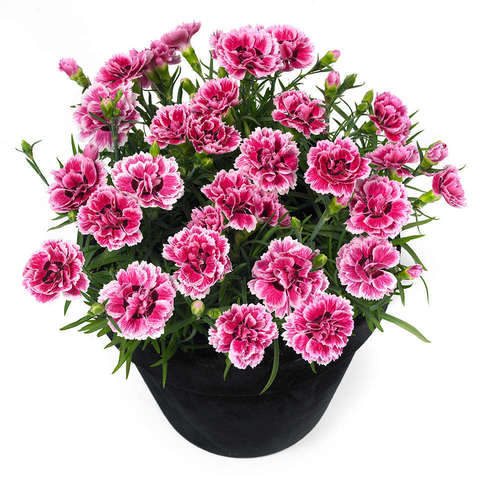

"Sops-in-Wine"
Carnation herbal photo
This type of carnation is quite widespread throughout Europe in the wild. A small perennial plant, 15–25 cm tall, forms a dense above-ground cover, during flowering, covered with a spectacular scattering of delicate flowers 1.5 cm in size, red, crimson, crimson, carmine or white with a pink border. The leaves of this carnation are small, narrow, dark green in color. Blooms profusely and for a long time, about 2 months, blooms in June. Gives abundant self-seeding.
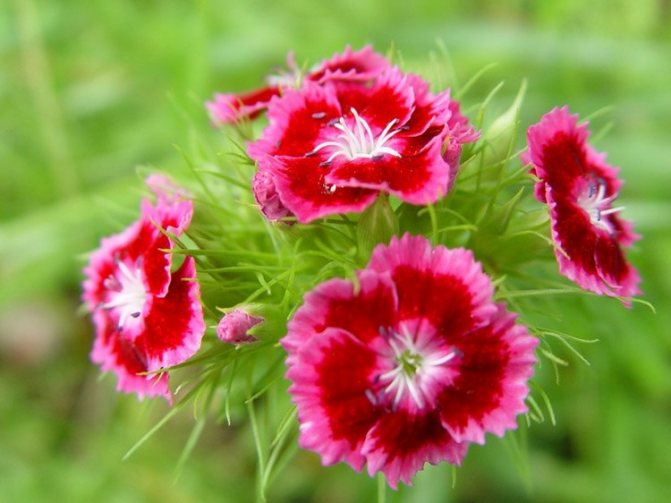

Modern varieties
Old-fashioned varieties were crossed with remontant varieties of garden carnation, resulting in a group of hybrids known as D. I allwoody (G. Alvuda), from which most modern varieties are derived. These plants bloom longer and more abundantly than the old-fashioned varieties.Their bloom continues from early to mid-summer and they form many more flowers. All of the varieties listed below, unless specifically mentioned, have double flowers.
In young plants, to give them a bush-like shape in the spring, it is necessary to pinch the growth points.
"Becky Robinson"
The flowers are lacy, with a ruby-red border on a pink background.


"Becky Robinson"
"Claret Joy"
The variety is dark red in color.
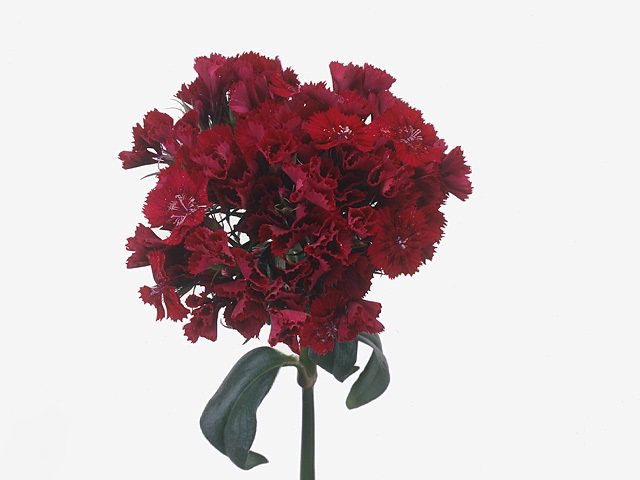

"Claret Joy"
"Granmere Pool"
The cultivar produces creamy white flowers with a burgundy center.
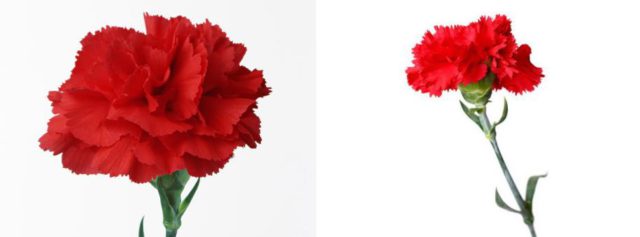

"Granmere Pool"
"Devon Cream"
The flowers are light yellow, with pastel magenta spots.
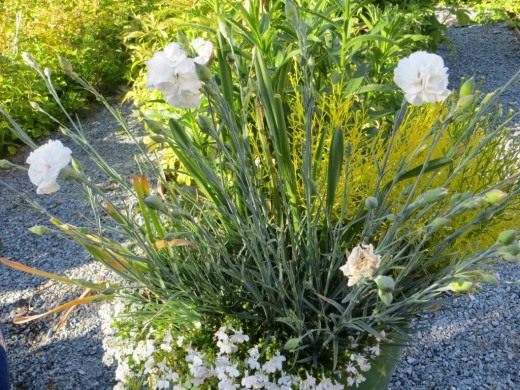

"Devon Cream"
"Devon Dove"
The variety forms white flowers with greenish eyes.
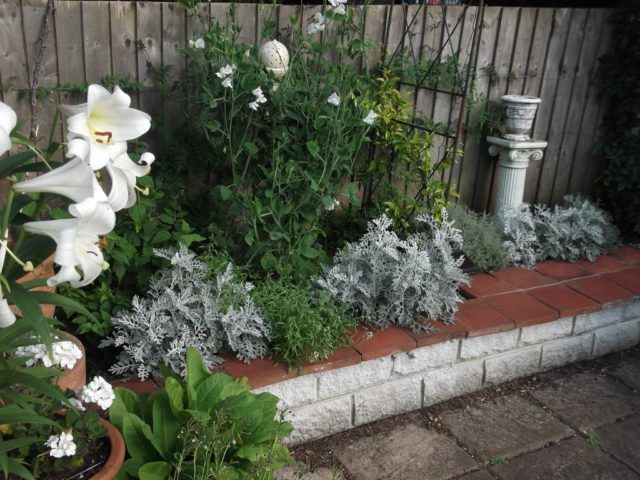

"Devon Dove"
"Devon General"
The flowers are dark red.
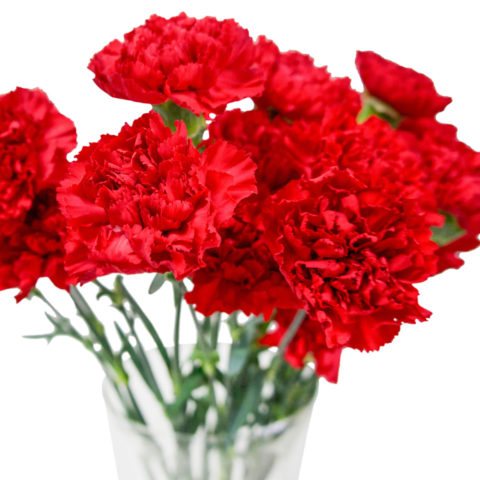

"Devon General"
"Devon Glow"
Cherry blossom flowers.
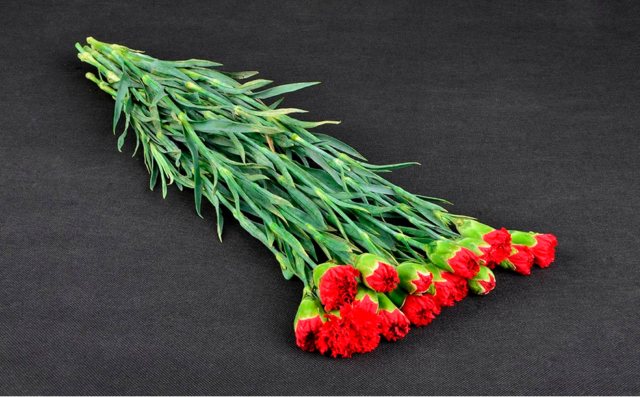

"Devon Glow"
"Devon Maid"
The flowers are white, with wine-red eyes.
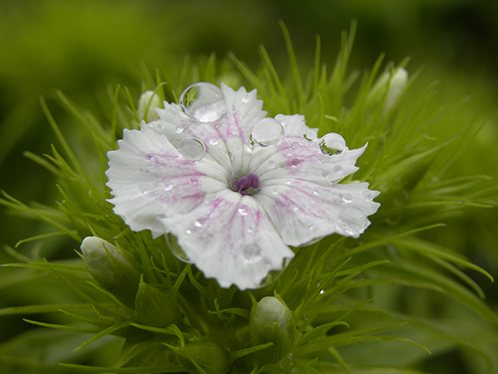

"Devon Maid"
Devon Wizard
The cultivar produces cyclamen purple flowers with a ruby red center.
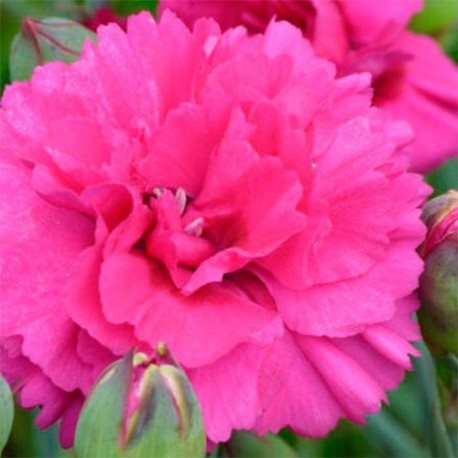

Devon Wizard
"Diane"
The flowers are salmon pink.
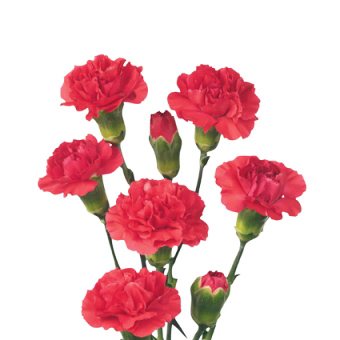

"Diane"
"Doris"
The flowers are salmon pink, with a bright red eye.
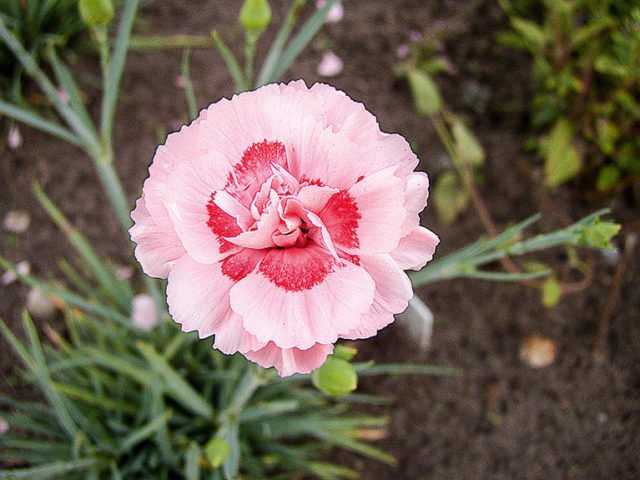

"Doris"
"Gran's Favorite"
The variety forms white flowers with a cherry border.
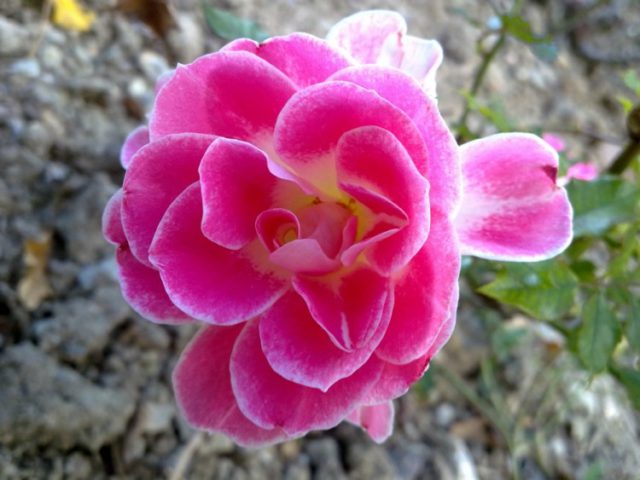

"Gran's Favorite"
Haytor White
The flowers are white.
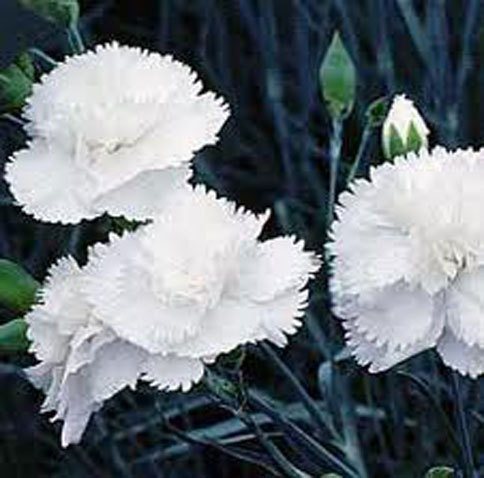

Haytor White
"Houndspool Cheryl"
The flowers are red.
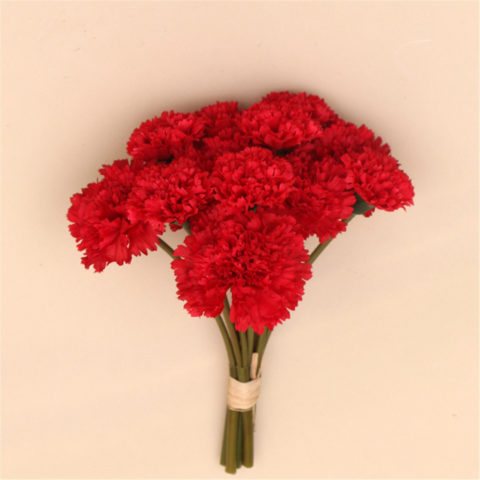

"Houndspool Cheryl"
"Houndspool Ruby"
The flowers are pink with a reddish center.
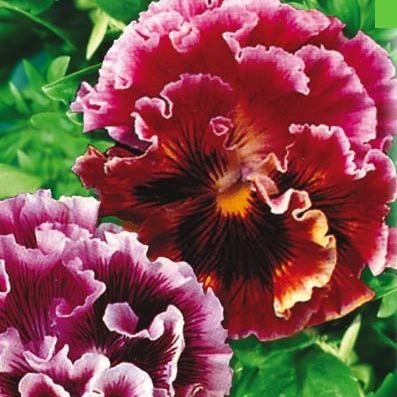

"Houndspool Ruby"
"Joy"
Variety with salmon pink flowers.
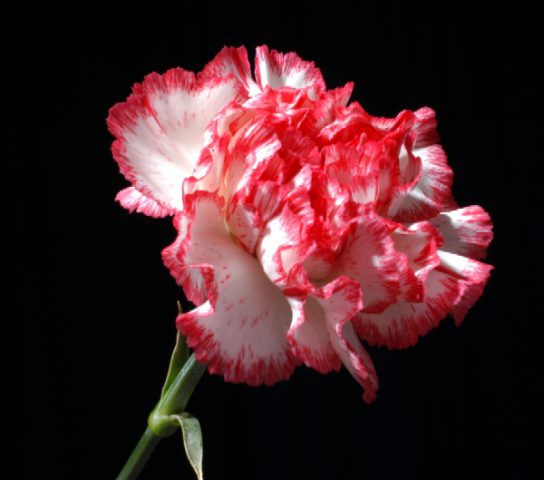

"Joy"
"Kesteven Kirkstead"
The flowers are simple, white, with a purple-red eye.
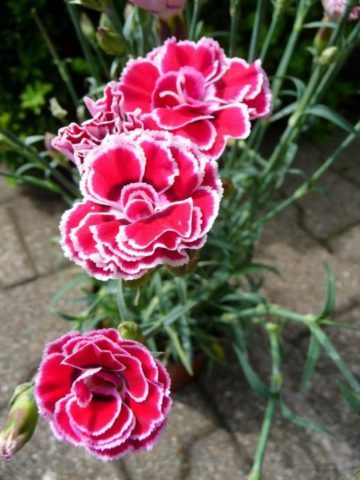

"Kesteven Kirkstead"
"Laced Monarch"
The variety has corrugated pink flowers with a burgundy central zone and border.
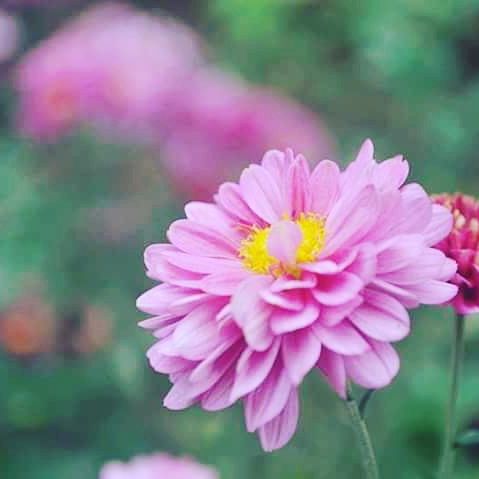

"Laced Monarch"
Lincolnshire Poacher
The flowers are simple, lavender-pink, with a wine-red eye.
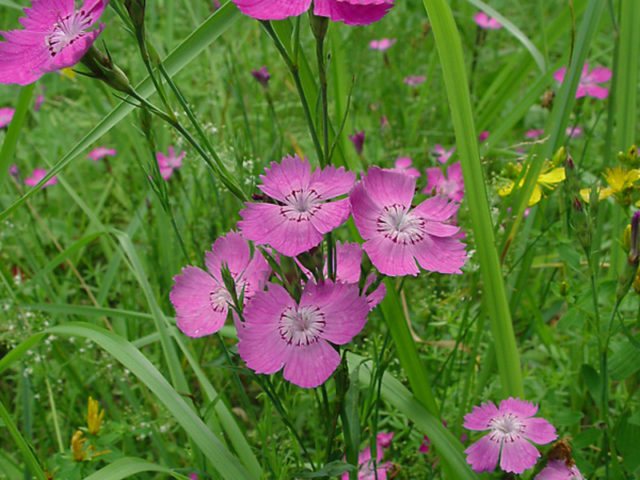

Lincolnshire Poacher
"Marg's Choice"
The variety produces light salmon pink flowers.
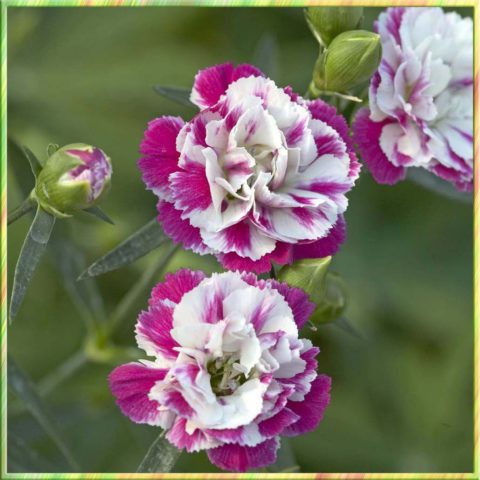

"Marg's Choice"
"Monica Wyatt"
The flowers are cyclamen-pink, with a magenta eye.
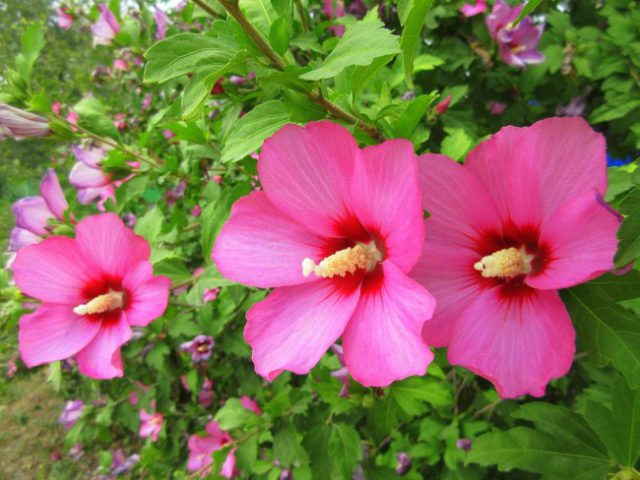

"Monica Wyatt"
"Old Mother Hubbard"
The cultivar forms pink flowers with spots or dots of a darker pink color.
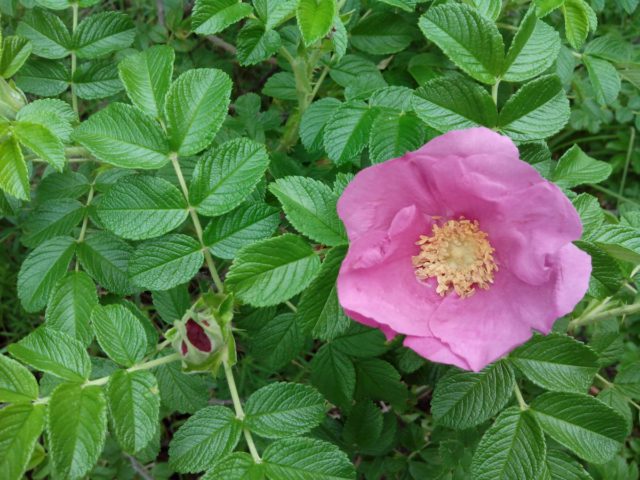

"Old Mother Hubbard"
"Strawberries and Cream"
The flowers are creamy white, with spots of two different tones of pink.
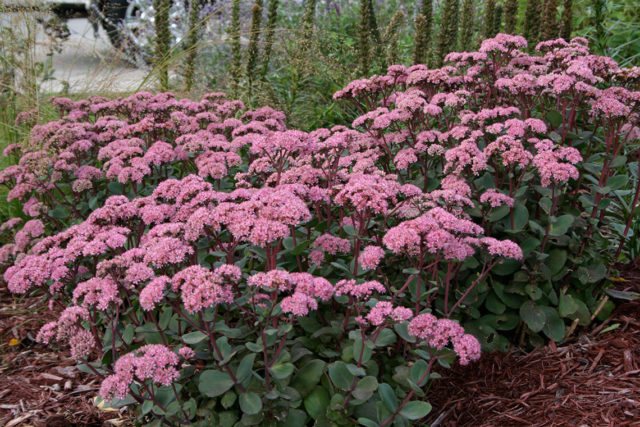

"Strawberries and Cream"
Valda Wyatt
The owner of lavender-pink flowers with a darker center.
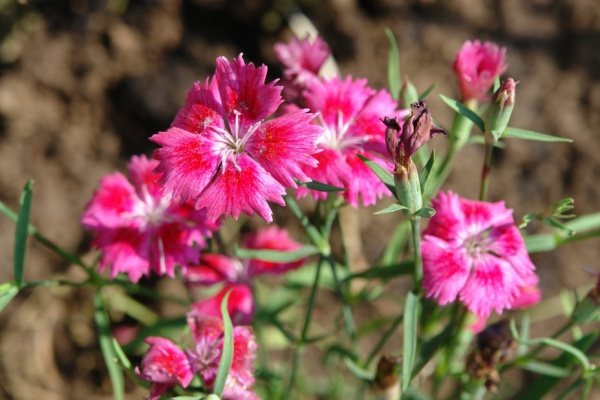

Valda Wyatt
Widecombe Fair
The flowers are pastel pink.
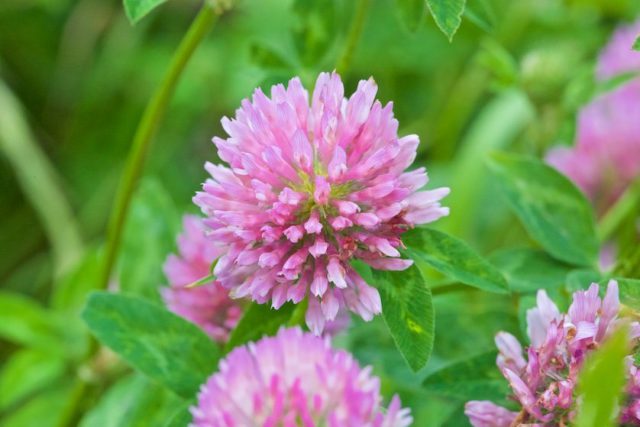

Widecombe Fair
Carnation pinnate photo
An unpretentious herbaceous ornamental perennial with knobby stems about 30 cm high, one of the most popular types of carnations in gardening. Fragrant flowers of medium size, about 3 cm, can be simple and double, in a variety of colors - from white to dark red. Blooms in May, flowering lasts about a month. There are also remontant varieties that bloom again in the fall. Carnation sand photo
A perennial plant with a height of 10–30 cm has numerous shoots and forms dense sod. Stems are green or gray. The flowers are single, about 2.5 cm in size, the petals are white or pink, dissected, similar to a fringe, have a pleasant aroma. Blooms in June - July.
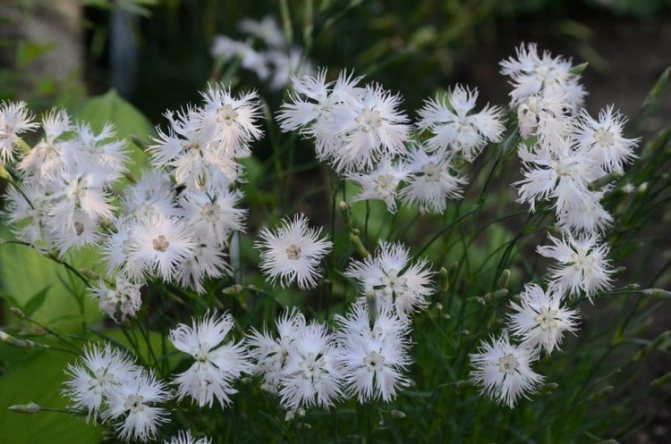

Alpine hybrids
Most species from the European Alps hybridize easily, producing many varieties suitable for growing in rocky gardens, containers, flower beds or sheltered from the summer rains in a glass alpine plant house. Plants form groups of rosettes or dense clumps of narrow gray or gray-green leaves and stems 7.5-15 cm tall. Most of them have fragrant flowers up to 3 cm in diameter with fringed or serrated petals.
Betty Norton
A variety with simple pink flowers and a purple-violet center.
When and how to plant a perennial undersized carnation
Perennial garden carnations are grown in seedlings. Seeds are sown at the end of February or in March, pre-soaking for a day. Prepare seedling boxes or other suitable containers with loose loamy soil. Seeds are spread on the surface of moist soil, sprinkled with a small amount of sand on top. The boxes are covered with glass or transparent film and left in a dark place at a temperature of 17–20 ° C. Shoots appear in 4–7 days. Containers with seedlings are placed on a windowsill, well-lit by the sun.Spray with water from a spray bottle. After 3-4 weeks, young plants dive into the soil of the greenhouse. Then the plucked seedlings are pinched to stimulate branching of the stem and growth of roots.
How to plant a garden carnation in a permanent place: Dig holes at a distance of 15-30 cm and a depth greater than the root ball. Add compost and sand in a layer of 3 cm to improve soil permeability. The seedlings are lowered into the hole, sprinkled with soil and compacted around the roots. Water the seedlings. Mulch the soil. Attention! Drainage is necessary to drain excess water during irrigation. Carnation does not tolerate waterlogging at any age. Young plants especially suffer from waterlogging. Direct sowing in the ground is carried out in mid-May. The seeds are deepened into the soil by 1 cm, covered with a film on top to accelerate germination and protect from the cold. As soon as shoots appear, the shelter is removed.
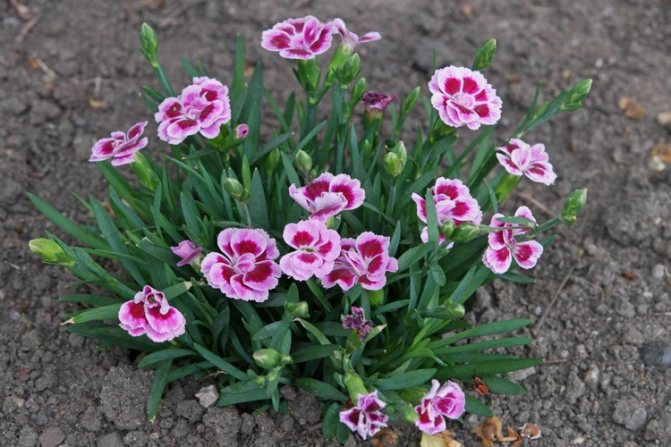

Growing
Wild species and alpine hybrids
Carnations wintering in the middle zone of Russia are grown as follows. Most alpine species and their hybrids grow well in open sun in rocky gardens or in well-drained flower beds in alkaline soil, although they tolerate neutral and slightly acidic soil. Smaller and more compact cushion varieties are great for container or pot growing in a glass alpine house. D. glacialis and I. microlepis prefer acidic soil. D. callizonus and D. glacialis require dry air, but their roots must be kept moist at all times. To do this, increase the moisture content of the soil by applying a large amount of organic fertilizers. D. deltoides is very unpretentious: its varieties tolerate partial shading, but under these conditions they do not bloom as abundantly as in the open sun.
Garden varieties and curb cloves
Plants are planted in late summer - early autumn.
Well-rotted manure or garden compost is added to the ground before planting, the soil is loosened with a rake and bone or fish meal is added. When planting, do not immerse the lower leaves in the ground.
After frost, it is necessary to check if the plant has come out of the ground. In open places, plants can be left to winter in a greenhouse under glass in dug-in pots with a diameter of 8 cm, and in early spring they can be planted in a permanent place.
Garden varieties obtained from crossing wild species do not need support. Provide the curb carnation with a support net in early spring when its shoots begin to stretch.
For curb carnations, remove the lateral buds for larger flowers. In plants of the first year of life, a small bud located below the apical bud is removed; in biennial plants, smaller axillary buds are also removed; in three-year-old plants, only two or three flowers are left on the stem.
In garden varieties, the buds are not removed. The flowering of modern varieties can be extended by cutting off the faded flowers and applying complex fertilizers in the middle of summer. In the second and third seasons, it is useful for both garden varieties and curb cloves to apply mineral fertilizers in the spring.
After three years, the shoots of plants are stretched and lignified, which impairs winter hardiness. It is best to regularly plant new young specimens.
Annual carnation
Before planting, prepare the soil in the same way as for growing garden varieties and curb carnations. Regular removal of wilted flowers prolongs flowering. Flower buds are not removed.
Repaired carnation varieties
Plants require bright light and good ventilation. Ideally, the greenhouse in which they are grown should be fully glazed to ground level. In late winter - early spring, rooted cuttings are planted in pots with a diameter of 6 cm in standard soil for seedlings.
After the plant has formed eight or nine pairs of leaves, the growth of the shoot is stopped by breaking it off exactly above the node from which the fifth or sixth pair of leaves grows. Side shoots will begin to grow from the axils of each leaf.
Before the plant fills the entire pot with its roots, it must be transplanted into a 15 cm pot of fresh potting soil. The plant must be tied to a pole about 1 m high.
Plant growth is stopped a second time when the lateral shoots form eight or nine pairs of leaves. As a result, many shoots will appear in the next branching order, each of which will eventually bloom. However, most often, only half of the lateral shoots are stopped growing in order to stretch the flowering time into summer and autumn. Further, behind this wave of flowering in winter, flowers are formed on the pinched shoots. Do not pinch all the shoots at the same time. Renal buds are also removed from repair carnations. On each stem, only the first apical bud is left, and all lateral ones are removed. Remove the buds gradually, since the simultaneous removal of all lateral buds leads to the splitting of the calyx in the flowers.
Do not overdry the plants, but avoid waterlogging. In early summer, shade the glass of the greenhouse, in hot weather, moisten the paths and the surface around the pots.
Plants that are grown in an artificial substrate should be fed six weeks after transplanting. If the plants are grown in soil, this is not necessary until the first flower buds appear.
Apply a balanced liquid fertilizer every seven days in summer and fall. In winter, feed monthly, but only when the temperature is above + 7 ° C.
In the second year, the plants are transplanted into pots with a diameter of 20-23 cm and supplied with support poles up to 1.2 m long. At the end of the second year, old plants are replaced with new ones.
Reproduction of a low-growing perennial carnation by dividing a bush
Mature shrubs with fibrous roots can be divided without harm to their health. Among perennials, this breeding method is suitable for the Turkish carnation. The procedure is performed in the spring. The advantage of the method is that the plant blooms in the same year.
Perennial varieties of carnations are successfully used in garden design. They are appropriate when decorating paths, flower beds and flowerpots. Drought-resistant species are planted between the stones of an alpine slide. Bright flowers look harmoniously next to conifers. See how a feathery terry carnation looks organically among the stones.
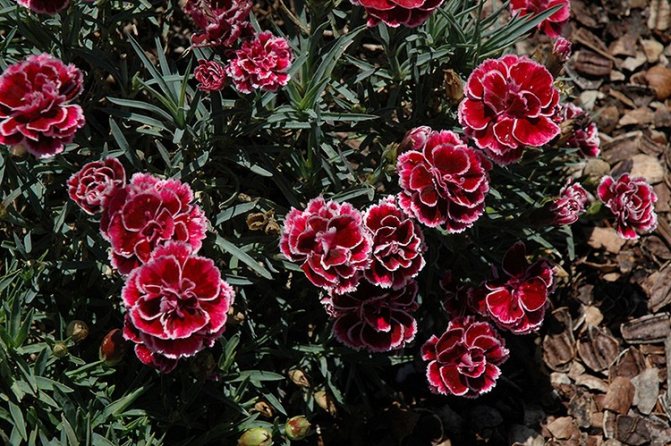

Sagina, Mshanka
Distributed in temperate and cold zones of Europe. It is an evergreen, soddy perennial that resembles moss, as the plants cover the soil with small pads, which are about 5 cm high, with a creeping, branchy stem. Refers to soil plants for shady and semi-shady areas.
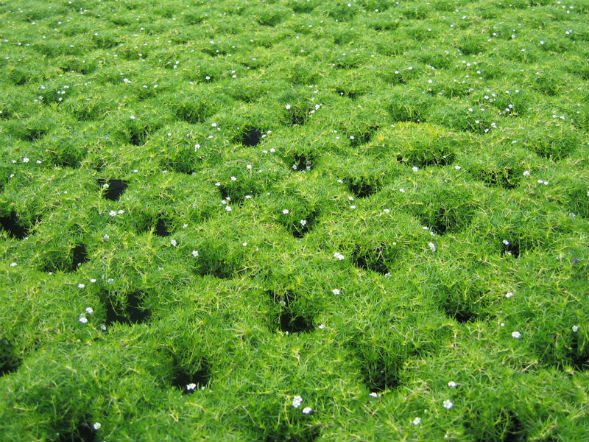

The leaves are small, miniature, acicular or linear, green in color, but there are plants with yellow leaves. The flowers are single, small, white, with a delicate delicate aroma, located on elongated peduncles, up to 20 cm.
Sagina blooms in July-August, the fruit is an oblong-ovoid capsule. Seeds are reniform, smooth, dark brown in color. The plant is propagated by seeds and small sod. Winter-resistant plant, grows well and develops in shady and semi-shady areas.
They are not whimsical in cultivation, the soil should be loamy, sandy, well-drained. They are planted in flower beds, ridges, in shady and semi-shady places.
Carnation care for undersized perennial carnations
Short perennial carnation has earned the status of an unpretentious plant in care. With proper incorporation into the soil mixture, it only needs watering and loosening with periodic dressings to stimulate flowering.
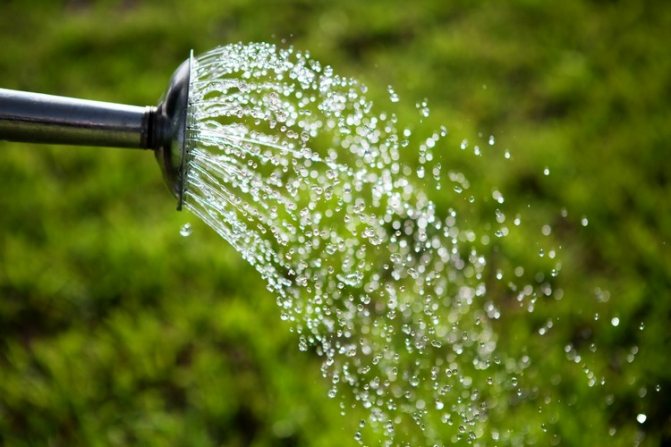

After the end of flowering (mid-autumn), the yellowed inflorescences are cut off. The landing site is mulched, closed for the winter.
In the spring, they re-weed and fertilize the area to stimulate re-flowering.
Temperature conditions: minimum values for planting + 15 ° C. Seedlings are actively developing at + 18-20 ° C. Withstands temperatures rise to + 30 ° C. In the home version of germination, plant at + 20 ° C and abundant lighting, and after the formation of the first rearrange the seedlings in a place with diffused sunlight.
Felt Felt
Homeland - Central and Southern Italy. The perennial has a low, dense bush, the height of which is 10-12 cm, belongs to soil plants for dry sunny places. The bush is formed due to the numerous thin, branched, creeping stems on the ground.
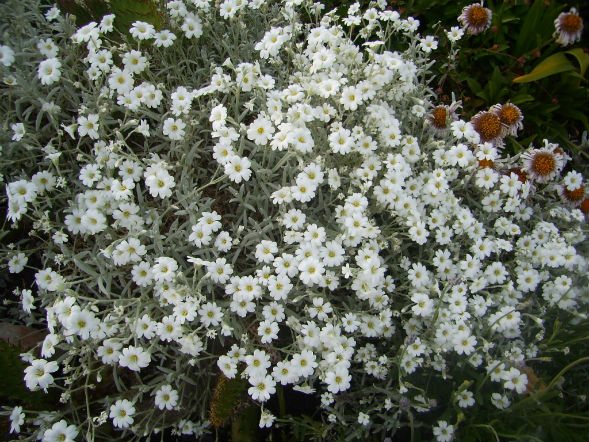

Leaves are small, linear-lanceolate, silvery-gray, rather densely located on the stem. Shoots and leaves of Yaskolka Felt well tolerate winter without shelter. Small, single flowers up to 1 cm in diameter, white, bell-shaped.
The plant blooms in May for a month. The fruit is a capsule, the seeds are small, slightly flattened, brown-black, ripen in July-August. This clove plant is propagated by seeds, by dividing the bush, by cuttings. Yaskolka Felt refers to frost-resistant, light-loving, drought-resistant plants.
The soil for its cultivation should be light, sandy, well fertilized. Growing without transplant for 5 years. The resulting colorful cover of Yaskolki Felt is used to decorate lawns in sunny areas and for rock gardens.
Diseases and pests of undersized perennial carnation
The most common pests are: Aphids Spider mites Nematoda To control aphids and spider mites, you will need to use soapy water or insecticides. If the plant is infected with a nematode, then it is recommended to dig them up, remove the affected areas. If the carnation is severely affected, then it is better to destroy it. And the soil needs to be treated with special preparations, for example, "Fosfomid". The most common clove disease is fungus. The reason is an excess of moisture in the soil. The appearance of the fungus can provoke an excess of nitrogen. Fungicides should be used as prevention and control.
loading ...
Silena, Smolevka
Homeland - Mediterranean. Herbaceous perennials, cloves, related to soil plants, the height of which is from 5 to 25 cm, with sticky, erect or lying, branched stems.
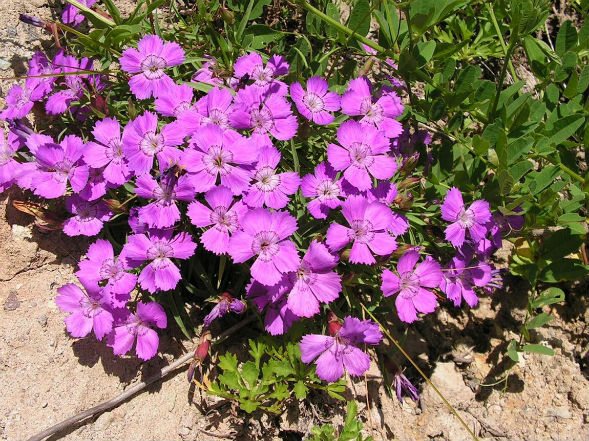

The leaves are small, opposite, lanceolate, acute-oval, gray-green in color. The flowers are single, five-leafed, star-shaped, white, purple, pink or yellow-greenish.
Plants bloom in July-August. The fruit is an egg-shaped capsule, the seeds are kidney-shaped, dark brown in color, ripen at the end of August. Plants are propagated by seeds and dividing the bush. Frost-resistant, light-loving plants.
They grow and develop well in open sunny areas. In shaded areas, weak flowering and tall, elongated stems are observed, due to which the decorative effect of these plants is lost.
The soil for cultivation should be sufficiently loose, sandy loam, well fertilized, slightly acidic, drained (that is, with the addition of sand and granulated crumbs). They are planted in flower beds, ridges, borders, stone gardens and rock gardens.
Two types of Silena are widespread: Silena stemless - pink flowers and Silena Primorskaya - white flowers.
Care
Sand carnation needs special growing conditions, which will require minimal plant care. As with most flowers and garden plants, for carnations, it is imperative to periodically weed from weeds, and it is also necessary to water on time. During the period of active growth, fertilizers need to be applied. As a top dressing, complex mineral fertilizers or humus are suitable. If there is a variety with long and thin stems, they should be tied up.
Carnations love sunny areas, do not tolerate dampness and stagnant water. They can grow in poor soils, but they thrive better in fertilized areas with neutral acidity. To reduce acidity, dolomite flour can be added to the soil, saturating it with magnesium. Does not tolerate plant and heavy soil very well. To facilitate it, you can add river sand or peat, otherwise the carnation will not bloom.
It is advisable to apply fertilizer just before planting and during active growth. Attention should also be paid to the fact that chlorine is not included in the fertilizer, as it can destroy the plant.
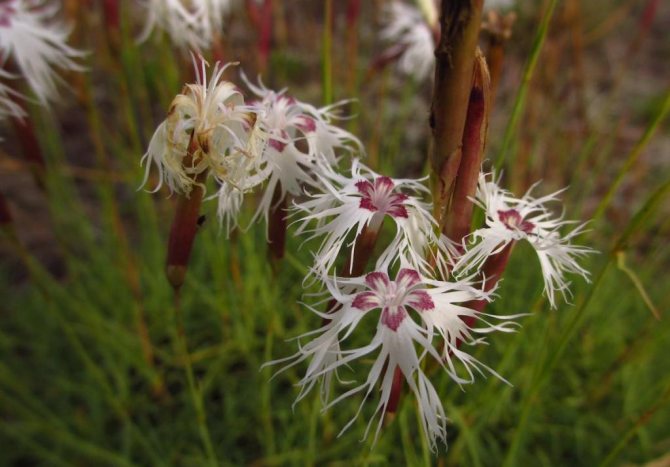

Seeds and seedlings
The seeds of annual plants are planted in boxes in early spring. Seedlings will appear in 2-3 months, but only with the onset of heat, the seedlings are placed in open ground. Turkish carnations and Shabo are sown in February, and perennial garden plants in March.
Biennials such as Turkish and Grenadines are planted outdoors in May, but these plants will not bloom until the following summer.
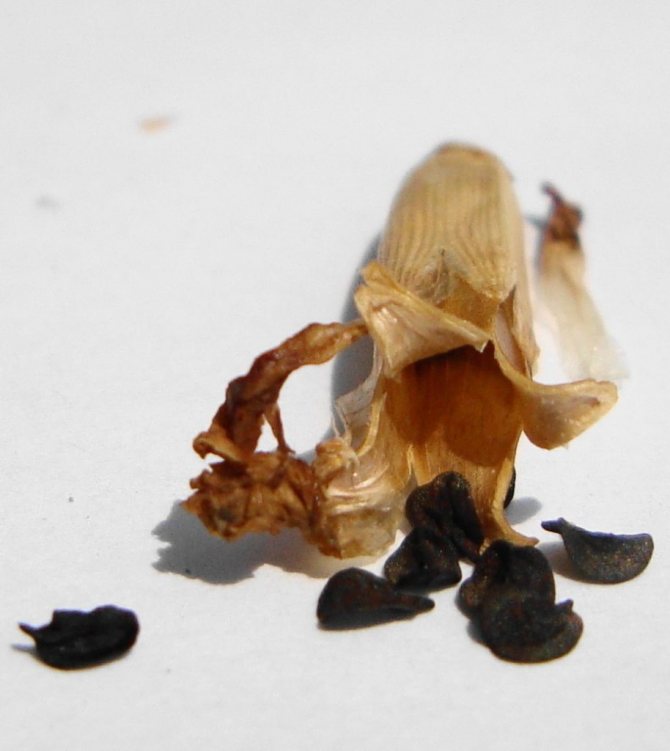

Seeds
To plant seeds, you will need containers with a moist substrate of earth and sand in a 2: 1 ratio. Due to the small size of the seeds, they are sown on the surface of the soil and slightly crushed with earth, moistening the substrate from a spray bottle. A weak solution of potassium permanganate will help protect seeds from fungal diseases. The containers are covered with polyethylene and placed in a warm, bright place. When the seeds sprout, the greenhouses are opened.
Seedlings are planted in small pots at a distance of at least 5 cm from each other, periodically water and make sure that the ambient temperature does not fall below 20 ° C. A decrease in air temperature slows down seedlings.
back to menu ↑
See also: Marigolds (Chernobrivtsy) are one of the best annuals. Description, growing from seeds, planting and care, possible diseases (80+ Photos & Videos) + Reviews
The procedure for sowing seeds and growing seedlings
- Preparation of a mixture consisting of sand, turf, peat or some other nutritious soil.
- Calcining the prepared mixture to destroy parasites.
- Planting seeds in a container with prepared soil and dusting them with a layer of sand several millimeters thick.
- Creation of a greenhouse effect (the pots are covered with a film in which holes are pierced for the passage of oxygen).
- Creation of the optimum temperature for seed germination (approximately +18 degrees).
- Decrease in temperature to 12 degrees when the first shoots appear.
- Creation of good lighting in the room (illumination with a phytolamp and a fluorescent lamp will also be beneficial).
- Moderate watering (excess moisture can damage the plant by the black leg).
- Diving of seedlings after the appearance of at least 2 leaves (distance between plants - 3 X 4 cm).
With the arrival of April, the plants should be moved to separate containers, leaving the root collar on the surface. When five leaves appear, the growth point is slightly pinched. From the same month, the carnation should be hardened, but always protecting it from drafts.
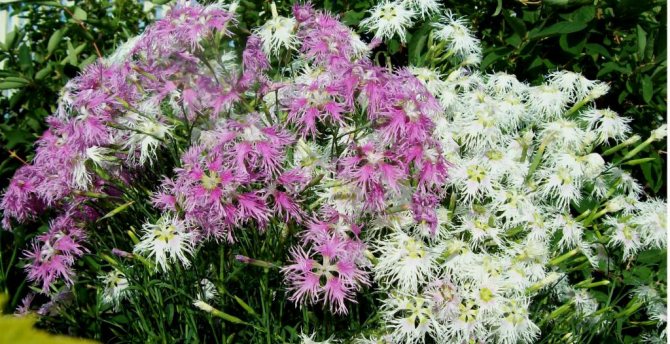

Popular species and varieties
Up to 350 types of carnations have been classified to date... Most of them are found in the Mediterranean countries, and some species grow in Asia, Africa and even North America. In countries with hot climates, the plant can bloom all year round. About 20 species and varieties grow on the territory of Russia in natural conditions.
Ornamental gardening surprises with new hybrid varieties every year, because most types of culture easily interbreed with each other.
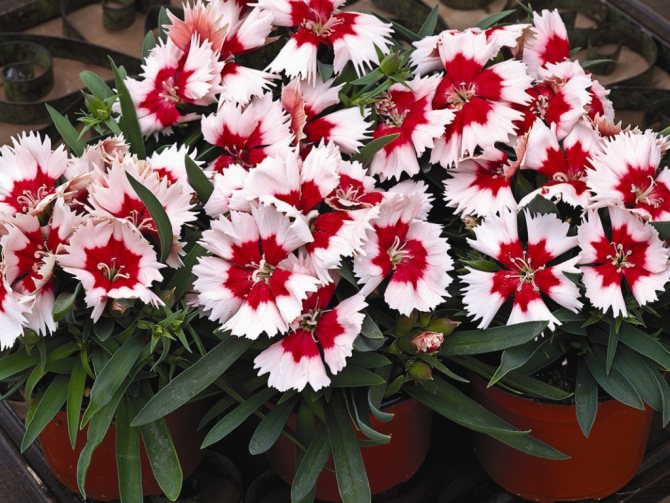

Chinese carnation
All types of carnations are conventionally divided into three groups:
- Annual plants that bloom in the year of sowing
- Biennial plants that develop in the year of sowing and bloom only the next
- Perennial garden carnations
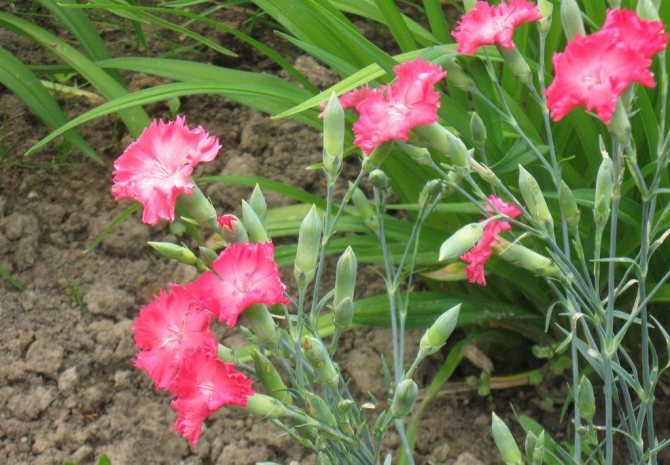

Carnation Grenadine
Shabo, Dutch and Grenadine carnations - annual plants with large double flowers (up to 8 cm in diameter) on a long stem. Their varieties are grown for cutting for flowerpots.
It is very difficult to grow varieties of these species in flower beds of a summer cottage or a personal plot: long, slender stems should be protected from wind and precipitation by a canopy.
A two-year-old Turkish carnation with a thyroid inflorescence forms a peduncle stem in the first year after planting, the structure of which is more powerful than that of other species. In the second year, inflorescences with characteristic color circles bloom.
Perennial garden carnations do not differ in double flowers, but their petals have an interesting border and rich aroma, such as a feathery carnation. These flowers are suitable for landscape design: they are used to decorate alpine slides and garden beds.
back to menu ↑
See also: Eustoma (Lisianthus) (100 Photos) - planting and care at home. An extraordinary plant in your garden + Reviews
Herb (Dianthus deltoides)
Grass - unpretentious perennial species. Unlike its light-loving relatives, the herb does well in shaded areas. Lack of moisture and care does not affect flowering too much. The plant can be found naturally in the field, forest, meadow. Shades of grass are varied - from bright scarlet and crimson to white.
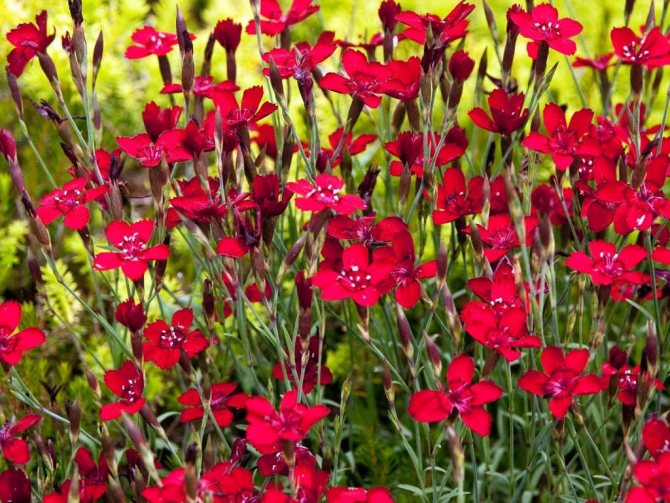

Clove herb Slendens
The stem length is up to 20 cm, the rhizome is short. Without a transplant, the plant develops and blooms for 4 to 7 years. Able to spread by self-seeding.
- Splendens variety - hardy plants with pink flowers.
- Variety Diamond - differs in abundant flowering, burgundy shade and delicate aroma.
- Albus variety - snow-white carpet.
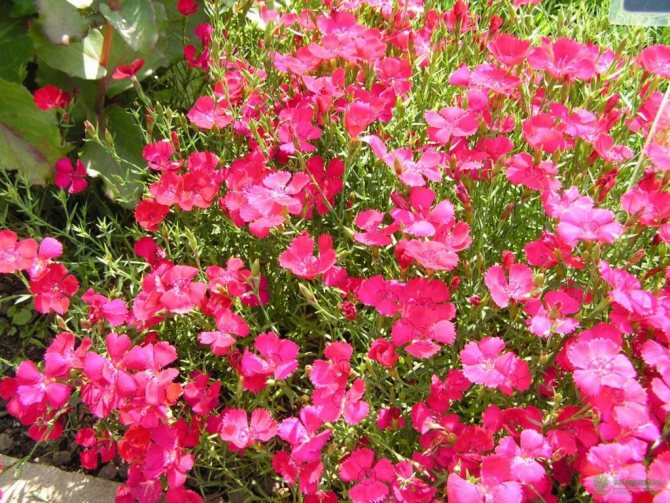

Carnation herbaceous grade Brilliant
The herb blooms for about a month and a half, starting at the end of June.
Planting seeds and seedlings
- After the end of the flowering season, grass seeds are carried by the wind to the nearby area.
- For planting, select a well-lit area and proceed when the outside air temperature rises above + 15 ° C.
- If the soil is warm enough, the seeds are planted directly into the open ground, but more often this species is sown on seedlings, and already grown seedlings are planted in a permanent place.
- In early spring, seeds are sown in rows in small boxes with loose, fertile soil. At the bottom of the box, a layer of expanded clay must be poured. The seeds are watered, sprinkled with earth and a layer of sand. The greenhouse is covered with plastic wrap and placed in a well-lit place.
- From time to time, the boxes are ventilated and watered, preventing waterlogging of the soil. The emerging seedlings are planted in small groups in peat pots or plastic cups. Saplings are planted in the ground in mid-May.
Reproduction methods
- In addition to seeds, the plant propagates by cuttings and dividing bushes.
- Cuttings are cut under the leaf knot in early May and placed in a mixture of soil and sand for disease prevention. The cut shoots are placed under a plastic greenhouse to create high humidity.
- It is better to divide the overgrown carnation bushes in early March. Then the plant will bloom in the same year.
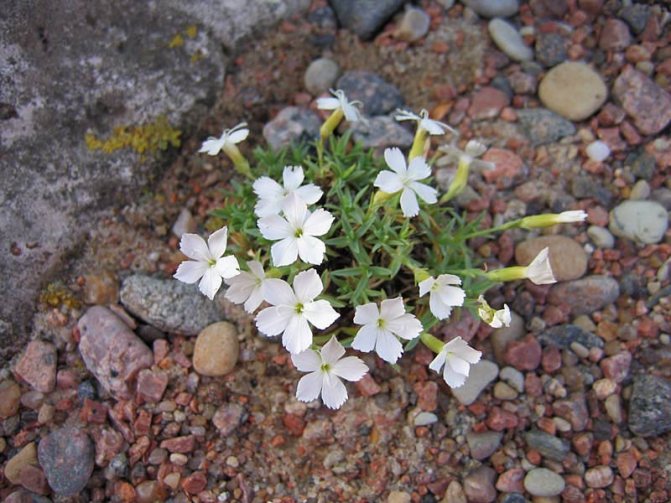

Carnation herbaceous variety Albus
Watering, feeding
- Grass bushes are fertilized 2 times per season: mineral and organic fertilizers. Even in severe frosts, the grass does not need to be wrapped. During the flowering period, watering is quite rare.
- Carnation bushes grow so densely that weeds have no chance to break through them, so the plant does not need weeding.
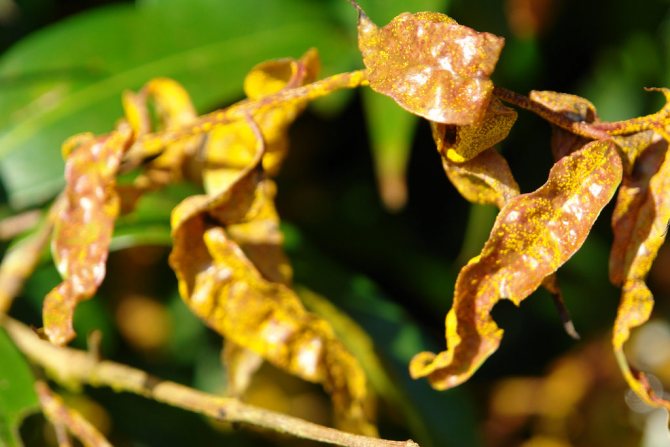

Alternaria in herbaceous carnation
Diseases
- Hardy herb is prone to fungal diseases.
- In spring, specks and spots may appear on the leaves of the plant. The reason for their appearance has not been established, presumably, this occurs under the influence of the close proximity of lilac bushes.
- Fusarium fungus leads to yellowing and wilting of leaves.A characteristic sign of fusarium in a carnation is that the stem begins to rot at the root, its color changes from gray-green to red-brown. During the period of the disease, the flowers do not bloom completely.
- Brown spots with black bloom on the leaves indicate alternaria. This is a fungal disease, due to which not only the flowers wither, but also the whole plant dies.
- It is worth getting rid of diseased plants, and treating the soil under them with a fungicide. It is not recommended to plant grass in this area anymore.
- Rust fungus is easily identified by brown and yellow spots. It infects stems and leaves, which are pruned and sprayed with a fungicide.
- To prevent fungal diseases, the soil under the plant is mulched and applied to non-phosphorus and potassium fertilizers.
- Thrips, nematodes and bears are another category of carnation pests. To combat them, before the start of the cold season, the ground around the flowers is dug up so that the pests will die with the onset of frost.
back to menu ↑
See also: Pansies: 10 species, a description of the process of growing from seeds in the open field and seedlings at home, the use of flowers (60+ Photos & Videos) + Reviews
Turkish (Dianthus barbatus)
The cold-resistant and unpretentious type of carnation is cultivated throughout Russia, although the natural habitat of the culture is the warm Mediterranean countries: Turkey, Croatia, Italy and Spain.
The Turkish variety is a biennial plant with a short (35-75 cm) strong knotty stem and oblong leaves of bluish and reddish shades. Thyroid inflorescences with pink, white, red and cream shades of flowers.
- Variety Scarlet Beauty - bright scarlet inflorescences, stems up to 50 cm high.
- Diadem variety - dark flowers with white spots in the middle.
- Ugolyok variety - fantastic black and crimson flowers.
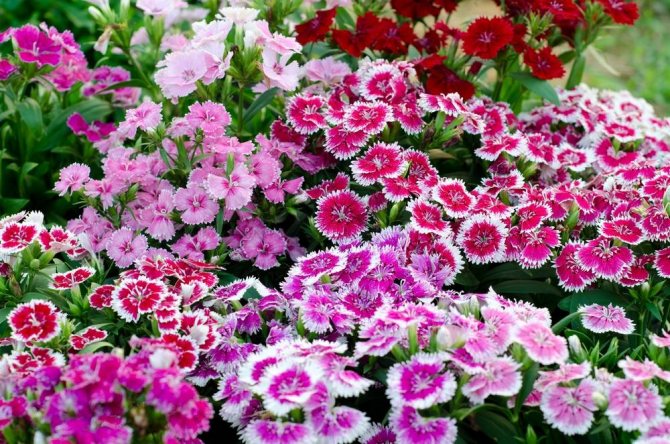

Turkish carnation
Reproduction
- Seeds of a Turkish carnation are placed in a greenhouse to a depth of 1 cm and kept at a temperature of +18 ° C until shoots appear. A mixture of sand and leaf humus is suitable as a substrate.
- In order for the seedlings to grow stronger, after the appearance of the first leaves, the greenhouse is placed in a cooler room. As soon as the second pair of leaves is formed in the seedlings, they are dived into peat pots. Landing in a permanent place is carried out at the end of May.
- Seeds of this species can be sown directly in open ground, but this should be done no earlier than early June or late October. Autumn crops are mulched with a layer of peat.
- Unlike many other light-loving carnation species, little shading is acceptable for the Turkish variety.
- The site selected for planting seedlings is pre-dug up, compost or wood humus is introduced into the soil together with complex mineral fertilizers.
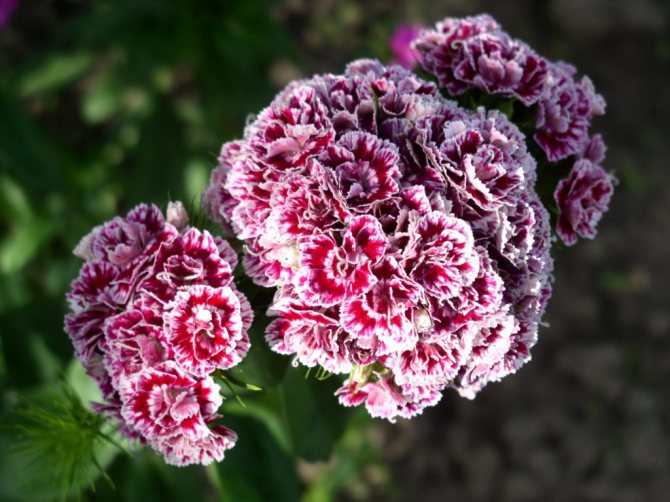

Another representative of the Turkish carnation
Watering, feeding
- Cloves are watered 2 times a week, and if dry hot weather is established, then more often. An excess of moisture in the soil is fraught with a disease called root rot, due to which the plant can throw off the root rosettes. After fertilization, the soil around the plant is loosened.
- You can achieve abundant flowering if you cut off faded inflorescences in time and weed weeds. Carnation hibernates under a layer of peat or humus.
Diseases
- The culture is very sensitive to heavy metals and engine exhaust fumes.
- The Turkish variety, like its relatives, is susceptible to fungal diseases: fusarium and rust. In the first case, diseased plants are destroyed, and the rest are treated with a fungicide solution or Bordeaux liquid.
- Of the pests, the plant can be annoyed by earwigs and bears, in which they fight by digging up soil under the bushes before the onset of cold weather and with the help of manure traps.
back to menu ↑
See also: Badan: description, types and varieties, planting and care in the open field, medicinal properties and contraindications (60+ Photos & Videos) + Reviews
Chinese (Dianthus chinensis)
Florists in Europe were introduced to the Chinese variety of carnation in the 18th century. The flower was brought from China by a missionary who returned to his native France. In Russia, the Chinese carnation turned out to be a century later.
Today there are countless hybrids and varieties of flowers. Even a novice gardener can grow a plant on his backyard. Some hybrid varieties of this species can even bloom indoors or on a glazed veranda.
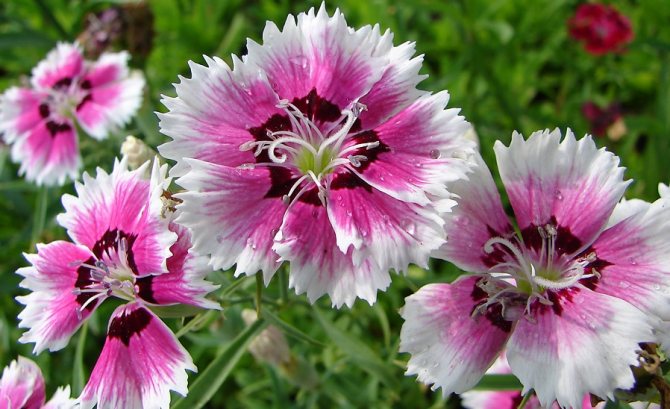

Chinese carnation
The natural habitat of a perennial herb is North China, Korea, Mongolia.
A low bush reaches a height of 50 cm. The leaves are oblong, arranged in pairs. Basic shades and colors: burgundy, pink and white. Flowering lasts from early to late summer. In the garden, bushes of Chinese carnations overwinter under a layer of compost or fallen leaves.
- Variety Dance of the Geisha - non-double carnations up to 3 cm in diameter, scarlet with a weak pleasant aroma.
- Grace grade - lilac and bright pink flowers with white edging.
- Variety Diamond - Terry dark red flowers with serrated petals.
- Hybrid grade Grace - undersized shrubs with double flowers, well suited for landscaping lawns, but can also grow indoors.
Planting seeds
- Seeds are sown for seedlings in March, planted in the ground in early May. If a greenhouse with seeds is installed on a north or east window, additional lighting will be required. On cloudy days, be sure to include a phytolamp. If the seedlings are unnaturally elongated or lodged, this is a clear sign of a lack of sunlight.
- Saplings tolerate changes in daily temperature well. The distance between seedlings when planting in the ground should be up to 20 cm (for dwarf varieties 10 cm).
Carnation seedlings
- Do not use peat-based mixtures as a greenhouse substrate, prefer nutritious garden soil in combination with sand or vermiculite. The seeds are immersed in the ground at a distance of no more than 0.5 cm and watered with water through a fine sieve.
- The first weak sprouts are not recommended to be watered from a watering can; it is enough to spray them from a spray bottle. After watering, the soil should dry out completely, otherwise there is a risk that the seedlings will get sick with a black leg.
- In order for the seedlings to grow more dense, after the appearance of 2 leaves, pinch the growth point.
- The grown seedlings are seated in plastic cups and hardened in an unheated room after the night temperature rises above 0 ° C. Such seedlings subsequently develop faster and do not get sick.
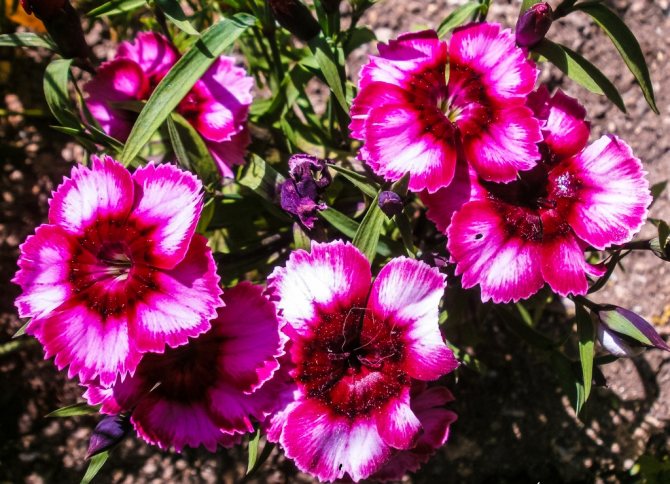

Chinese variety
Top dressing and care
- Seedlings are planted in loose fertile soil, which lacks fresh organic matter. For abundant flowering, choose a flower bed that is not shaded by other plants.
- Avoid dense planting of seedlings: so it will be more difficult for plants to cope with fungal diseases. After planting, mulch the soil with old compost.
- Complex fertilizers are applied to the soil 2 times a month.
Diseases
- Typical for representatives of the genus carnation.
back to menu ↑
See also: Perennial asters: description of 13 species, care and planting at home, methods of reproduction and growing from seeds + Reviews
Dutch (Dianthus caryophyllus)
Perennial plant, cultivated in Europe and the Mediterranean countries as a biennial... The tallest of the existing carnation species (the stem reaches a height of 1 m). Stems are gray-green, knotty, with small, oblong leaves. The buds are rich in color with a strong characteristic aroma.
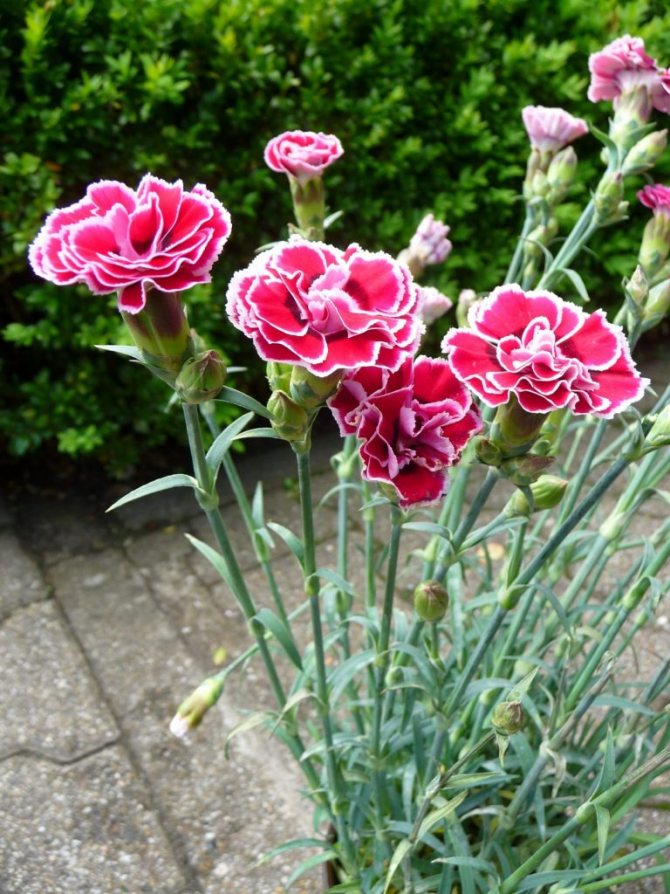

Garden Dianthus caryophyllus
- Variety Grenadines - pink and red buds.
Landing place
- Find a well-lit garden area with moderately moist, neutral soil. Sandy and sandy loam soils are well suited. Lime, chalk or dolomite flour are added to an overly acidic soil.
- Cloves will not be able to grow in clayey, wetlands with poor substrate air permeability.
Sowing seeds and care
- The Dutch carnation does not tolerate daily fluctuations in air temperature, so it makes no sense to plant seeds directly in open ground.
- The seeds are sown in greenhouses in March; garden soil mixed with sand and ash is used as a substrate.
Watering, loosening the soil and fertilizing
- Once a year, the soil is fertilized with complex mineral fertilizers during irrigation. Compost and other organic compounds are used with great care, since their excess can provoke the development of fungal diseases.
- You should not be zealous with loosening the soil around the carnation bushes, so as not to damage the shallow root system of the plant. Be sure to remove any soil crust that forms after a heavy rain shower.
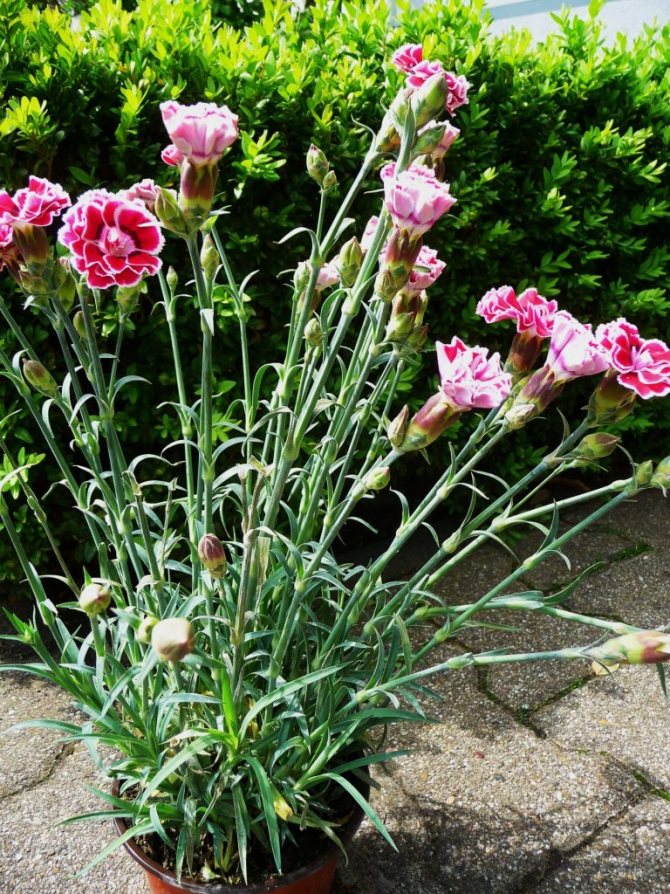

Planted in a pot
Pruning and supporting
- The faded buds and shoots on which they were located are carefully cut off. Such measures will contribute to the growth of new shoots and their flowering. Experienced growers pinch bushy varieties, thereby increasing their branching.
- High varieties are tied up, covered with a canopy from the wind and props are installed so that thin stems do not break under the weight of large inflorescences.
Winter period
- Some perennial varieties react painfully to low temperatures in spring.
- Frost-sensitive plants with the onset of cold weather are covered with a covering material.
- In this state, even young carnations withstand snowy winters perfectly. Spruce branches are removed not earlier than April.
Diseases
- Gray rot, rust and bacteriosis - typical diseases for representatives of the genus clove. They happen from stagnant water in the soil and from an excess of organic matter in its composition.
- To prevent diseases, plant calendula and marigolds next to carnations, and treat the bushes with Topaz for treatment.
- Insect control: For bears and earwigs, prepare a special trap in the form of a hole with manure before the onset of frost near the place where carnation bushes grow. Insects that live in the garden will crawl into this hole to winter.
- You can fight pests with a solution of laundry soapwith which their minks are poured. Earwigs can be lured in the summer on a shock of damp grass. Plants affected by spider mites are sprayed with onion husk or tobacco infusion.
Site selection and soil preparation
An inhabitant of dry heights, the herbal clove prefers dry areas open to the sun. When placed in a flower garden, low bushes are positioned so that they are not shaded by larger plants. Scattered partial shade from a dwarf birch or pine, found in the midday heat, is acceptable. In deep shade, the carnation will bloom poorly and develop poorly.
The species is grown as a perennial crop. For planting single seedlings or individual groups, it is advisable to prepare planting holes. Continuous preparation of the whole site is carried out if it is supposed to arrange a border or create a carpet from ground cover varieties.
Grass grows well on light porous substrates, limestone or sandy soils are optimal. It is unacceptable to plant plants on acidic, clayey, low-lying soils with stagnant water. Such land is first cultivated - water is taken away, sand is mixed with ground shell rock, acidic soils are limed.
Plants do not need nutrient-rich manure soils and may die when fresh manure is applied. For spring planting of seedlings, the site is prepared in autumn or early spring, thoroughly clearing weeds.
For digging or in the planting holes, sand, high-moor peat, leafy soil are introduced, seeking to lighten the soil and obtain a breathing structure. To avoid stagnation of water at the roots, drainage from expanded clay or shell rock is placed at the bottom of the planting pits.
Beneficial features
This plant has many beneficial properties. Sand cloves are used in folk medicine in the treatment of heart diseases, as well as for dry coughs and other colds. This plant is also useful for bleeding.
Usually, for the preparation of potions, the entire ground part of the plant is used: leaves, stems, flowers. You need to collect them during the flowering period.
The oil contained inside the flower is of particular benefit. Its main properties are antispasmodic, antibacterial. For effective treatment of colds, inhalation can be done using a few drops of clove oil. Also, when applying cotton wool soaked in oil to a sore tooth and other sore spots, you can get an analgesic effect. With problems with the gastrointestinal tract, with various skin diseases and with weak immunity, the liver, clove oil can also provide effective help.
Breeding features
Herb is a perennial plant, reproduction of which occurs by cuttings, seeds, as well as by dividing bushes.
- Cuttings are taken in the last days of May, at the beginning of June.
- Shoots are cut under the leaf knot, placed in a soil mixture with sand or perlite to prevent the occurrence of fungus.
- It is necessary to provide high humidity, so the plants are covered with a film.
Overgrown bushes are best separated in March.
, then the plants will start blooming in the same year.
Seed propagation is described above. One of the plant's advantages is self-seeding after overflowing. Self-seeding greatly facilitates care, relieves for several years from worrying about planting flowers.
Description of the medicinal properties of sand cloves
Sand carnation is endowed with rather valuable healing properties, while it is recommended to use the herb of this plant for medicinal purposes. The concept of grass includes stems, flowers and leaves of sand carnation. It is recommended to harvest the grass of this plant even during flowering.
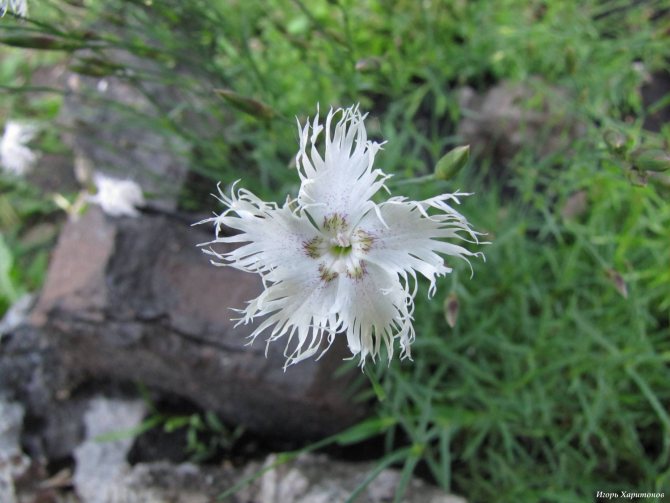

Such valuable medicinal properties are due to the content in the composition of this plant of saponins, flavonoids, phenolic compounds, carbohydrates, anthocyanins, D-pinite, and also traces of alkaloids, a derivative of gamma-pyrone diantoside. For pain in the region of the heart, as well as for coughing, it is recommended to use an infusion or a decoction made from the herb of sand cloves. In case of chronic fatigue, it is recommended to use the following remedy: for its preparation, it is recommended to take one tablespoon of dry crushed sandy clove herb for one glass of boiling water, such a mixture should be infused for about one hour, and then this mixture should be thoroughly filtered. To take a remedy based on sand cloves should be one tablespoon about three to four times a day. It should be noted that this plant is endowed with very valuable healing properties, the study of which continues to this day. It is noteworthy that today the properties of the sand clove are mainly used in folk medicine.
History, carnation legends
The earliest information about the carnation is found in the myths of Ancient Greece, after which the mention of it disappears for 12 centuries. Some historians believe that it was the crusaders who first brought the flower to Europe as a cure for the plague and a symbol of victory. At the time of Napoleon, the carnation color was chosen for the ribbon of the Legion of Honor.
European artists of the 16th century made carnation an indispensable part of portraits and still lifes. The flower is mentioned in Shakespeare's play A Winter's Tale. The fashion for carnations in England was introduced by Queen Elizabeth.
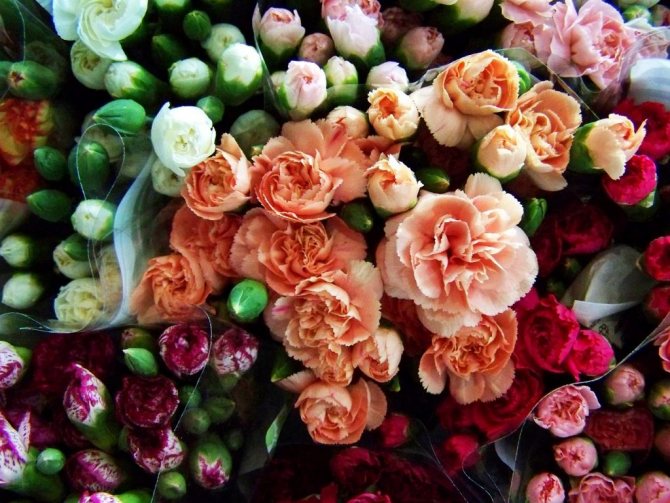

Carnation bouquet
Carnation is one of the symbols of the Soviet era. With red bouquets, Soviet citizens went to demonstrations timed to the day of the October Revolution. For more than 70 years in the CIS countries, the carnation has remained a symbol of victory in the Great Patriotic War.
back to menu ↑
See also: Euonymus: Description of the plant, species and varieties, cultivation, planting in the open ground and care, reproduction (65+ Photos & Videos) + Reviews
Description and characteristics of the plant
Carnation herb belongs to the carnation family... Due to the popularity in landscape design and the painstaking work of breeders, more and more varieties of flowers appear.
They are all characterized by vibrant colors and the ability to create a dense grass carpet. Doesn't require complicated maintenance and they winter well even in harsh climates.
Clove herb is correctly called deltoid carnation.... Herbaceous perennial with a branched, knotty and slightly pubescent stem. The plant has tough, narrow leaves.
The flower is formed by five petals with denticles along the edge. Bright flowers can be of all shades of red and in some varieties are collected in inflorescences. Bush height 20-40 cm.
The contrast of the juicy green of the stems and leaves, with many brightly colored flowers, looks very picturesque.
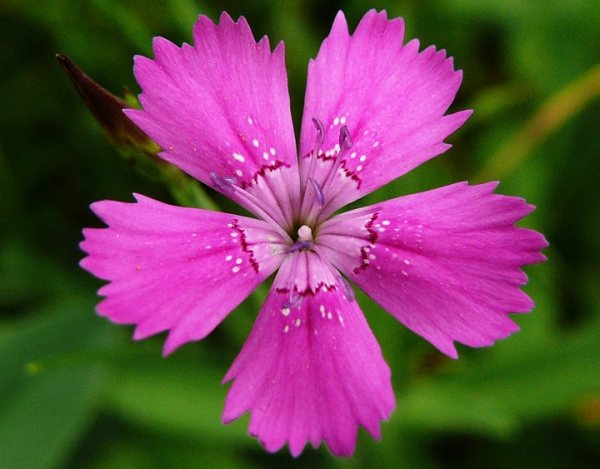

Herbaceous perennial 20-40 cm high, flower with five petals with denticles along the edge
Advantages and disadvantages
The undoubted advantages of the herbal clove are its unpretentiousness and ease of caring for the plant, it is enough long flowering period, high resistance to cold.
In addition, self-sowing propagation allows for several years not to plant the plants in the selected area.
The disadvantage is that the grass should not be planted next to tulips and lilacs... These flowers can facilitate the transmission of diseases from one to another.
A small perennial with bright flowers will perfectly decorate the lawn or add beauty to a cozy corner of the garden.
Seed collection
Taking care of a flower bed with a carnation herb, the gardener from time to time cleans the area of dried and yellowed flowers, but at the same time leaves the right amount for collecting seeds in the future (Figure 5).
Note: Only large and healthy flowers are suitable for collecting planting material. The time has come to collect it after flowering is indicated by completely dried petals and a change in the color of the box - it should become yellowish, beige or brown (depending on the variety).
It is important to remember that seeds harvested in an immature state are not suitable for propagation, as they simply will not sprout. If you did not have time to collect the boxes and left them in the flowerbed for the winter, it is possible that in the spring the plant will come off by self-sowing, which is typical for this variety of carnations.

